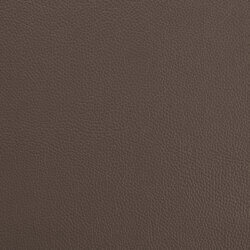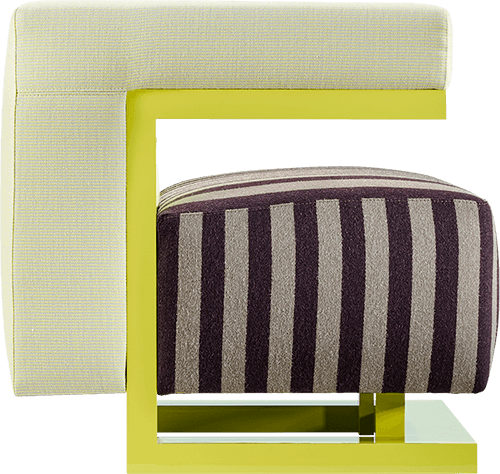
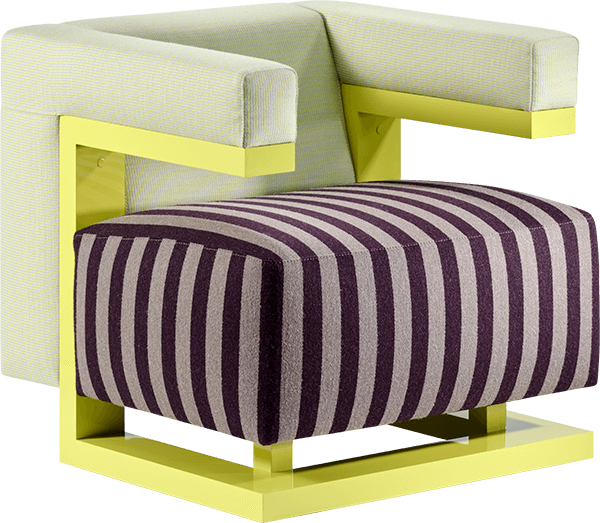
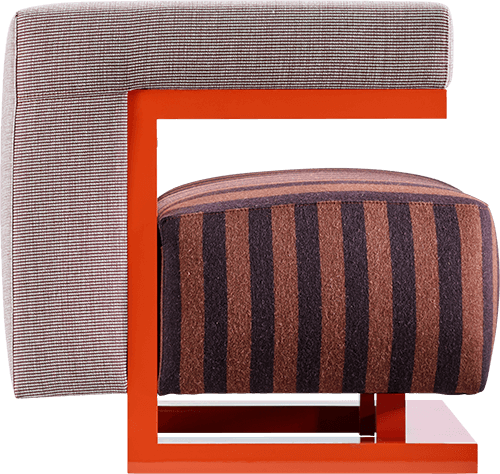
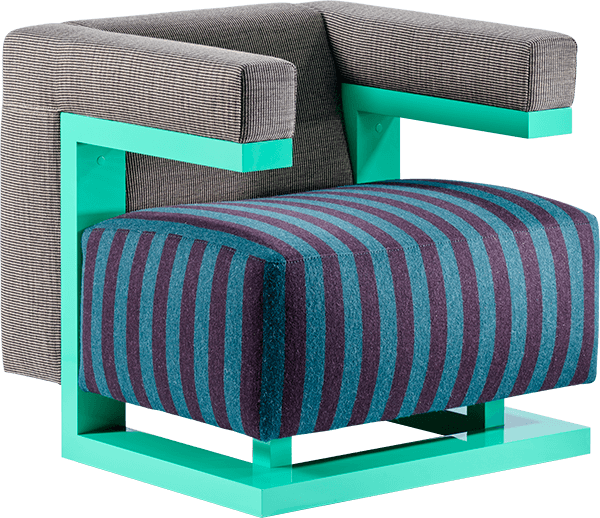
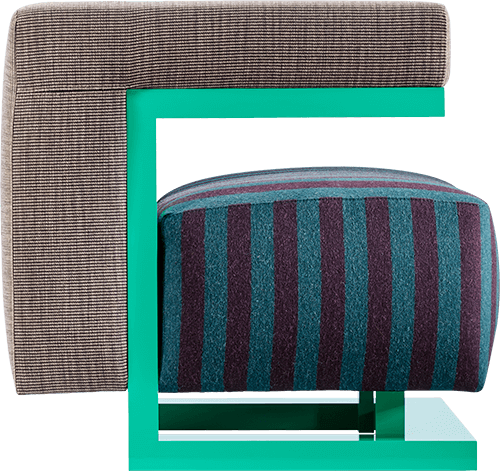
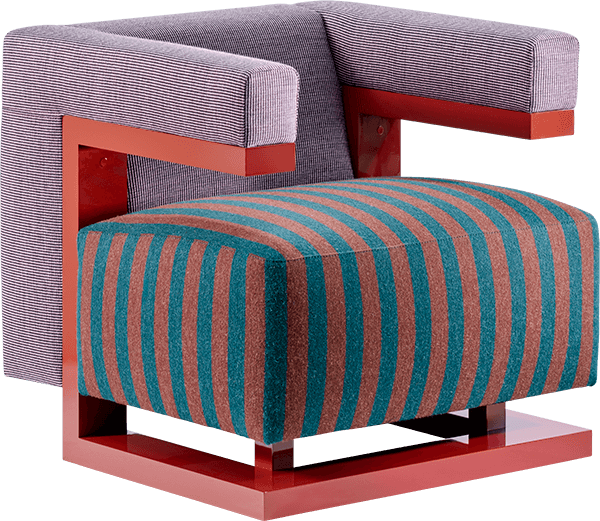
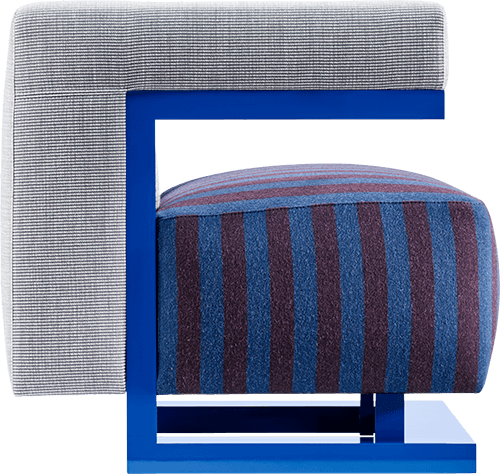
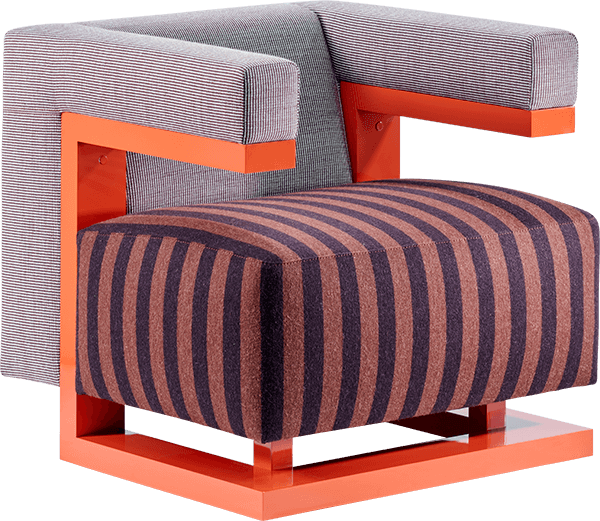
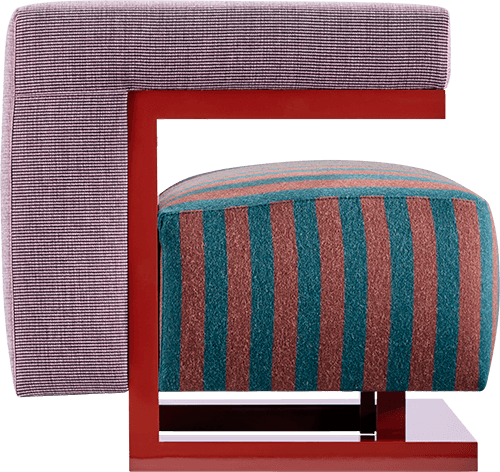
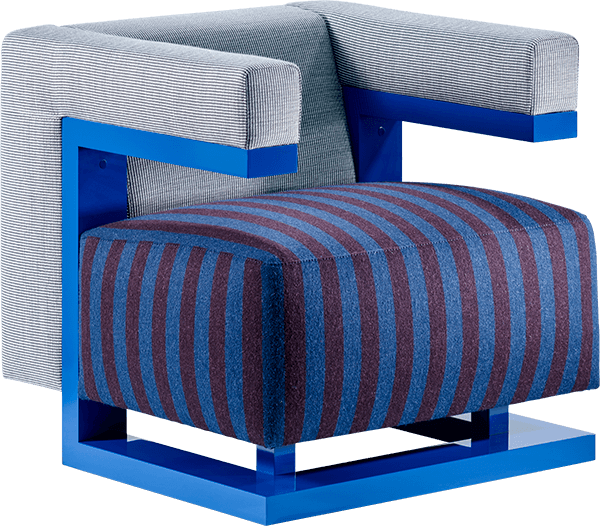
F51N
2019 & 2023
Gropius’ new clothes
It was the Roaring Twenties and there was something in the air: “Defying gravity and overcoming the earth’s inertia, in impression and appearance,” was the aim of Bauhaus founder Walter Gropius. Like the cubic cantilever design of his F51 Director’s Chair, these prophetic words stood for a new chapter of modern seating: the cantilever concept. The armrests of the F51 protruded freely and even the back of the chair did not touch the ground. A piece that embraced Lissitzky’s vision and was considered an innovation.
+ read more
- einklappen
For her new take on the F51 Katrin Greiling demonstrates how to rethink the iconic chair’s surfaces and colours. She presents the Gropius armchair in striking colour and texture combinations that change perspectives and draw attention. In doing so she has given the F51 a new face after 100 years. The fabrics she uses for this purpose were created by the Belgian fashion designer Raf Simmons for Kvadrat. Inspired by wool, twill and tweed, the collection features textures and colours that enable a transition to contemporary furniture.
Katrin Greiling divides the armchair into three design areas: frame, seat and armrest upholstery. She presents the distinctive geometrical wooden frame in six new colours realised with a high-gloss lacquer. Colour plays a major role in all her designs, and the same goes for the F51. She draws attention with colour and textures, emphasizing shapes and proportions. A primary source of inspiration for Katrin Greiling’s design approach to the task was the textile artist, Gunta Stölzl, director of the weaving workshop, whose importance to the legacy of the Bauhaus has often been overlooked. The F51 by Katrin Greiling is a marriage of geometry, colour and texture that skilfully connects the past with the present.




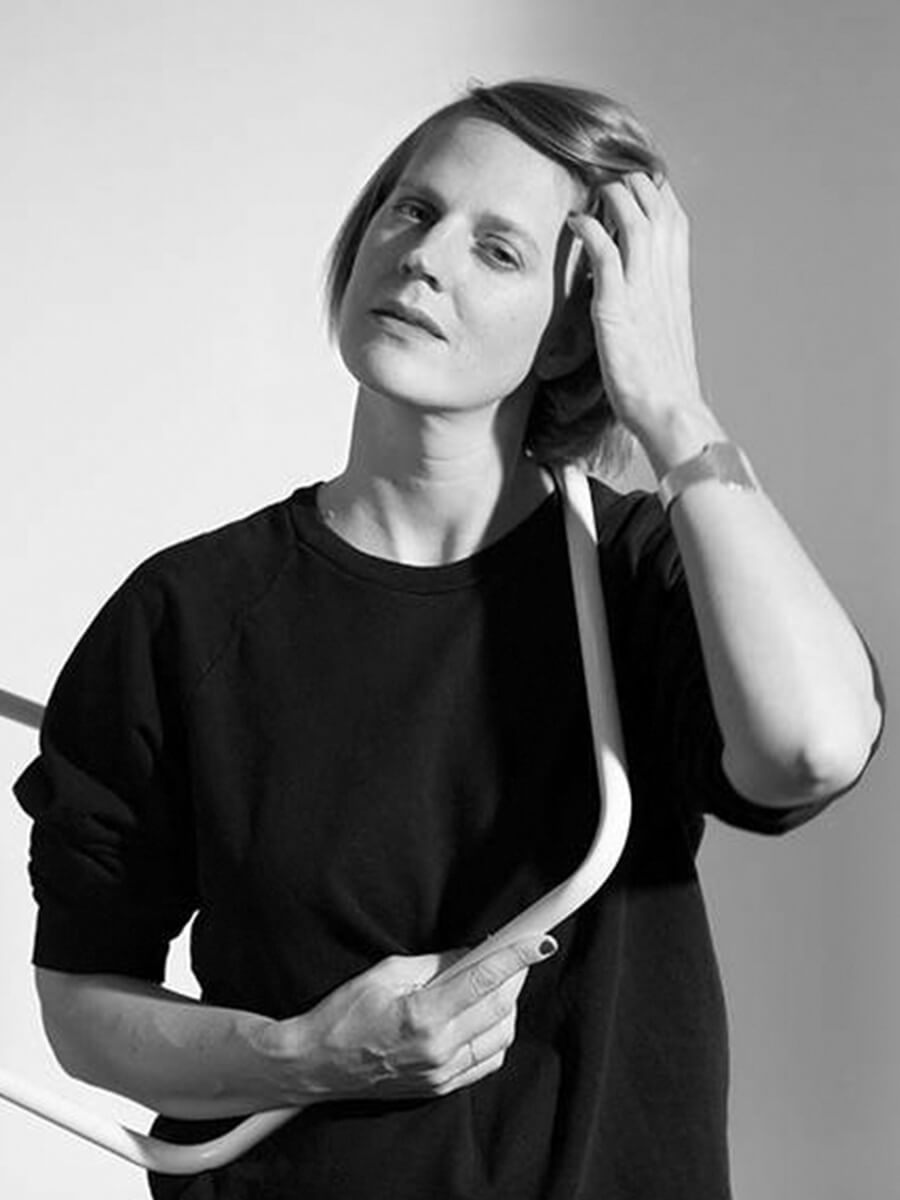
Born in Germany in 1978, Katrin Greiling left for Sweden in 1998 to study cabinet making and fine carpentry at Capellagarden. She continued her education with a 5 year master’s degree in furniture design and interior architecture at the prestigious Konstfack University in Stockholm. After graduating she started on a quest to explore design globally: During a three-year stay in Dubai she was commissioned to design global offices for a property developer. Research trips took her to Shanghai, Cairo and Istanbul. She studied the culture of the Middle East. Some important works were created during this period, including the Bidoun Sofa Series, consisting of stacked mattresses inspired by the daily life of traditional Bedouins.
+ read more
- einklappen
In 2013 she moved Studio Greiling from Stockholm to Berlin, Germany. Her work combines Furniture Design, Interior Architecture and Photography – an interdisciplinary mix, which enables her to tackle her projects from a variety of perspectives.
Studio Greiling’s creations have won numerous design awards and participate in many international projects and exhibitions. In 2010 she was featured in the first Wallpaper Handmade exhibition by the UK’s Wallpaper magazine. In 2012 she was one of the designers selected for the Halingdal 65 show by Kvadrat. Together with Etienne Descloux she developed the “Freunde von Freunden” x Vitra apartment in 2014 – a showroom and event space in Berlin. Her most recent collaboration was with Kinnasand. It took her to Milan for the Structures exhibition in April, 2018, which explored the interface between carpet and object.
In 2017 Katrin Greiling was appointed to the position of Professor of Product Design at University of Fine Arts in Saarbrücken.
Interview Katrin Greiling
Into the 21st century with colours and textures
What inspired you to give the legendary F51 by Gropius a new outfit?
Katrin Greiling: In autumn 2017 I started a project at HBK Saar with the question: How do the companies that inherited the Bauhaus legacy work with it? How do they create something new out of this heritage? I wrote to Tecta asking if they were interested in working with a university. And so a wonderful project was born, which gave me the opportunity to get to know the company and the people behind it. When we met again at imm Cologne in 2018 Christian Drescher asked me if I wanted to develop a new edition of the F51 chair by Walter Gropius.
+ read more
- einklappen
What were your first thoughts about changing the F51?
Katrin Greiling: I asked myself: How would I see the armchair in the context of contemporary furniture? I didn’t want to create a new design but rather to re-interpret and re-define the given framework of surfaces, textures and colours.
What aspect was key for your concept?
Katrin Greiling: The body of the F51 can be perceived in different ways. It consists of wooden and padded surfaces. The question that interested me was: Should one separate these surfaces with contrasts or combine them harmoniously? Colour plays a key role in all of my designs. Colour allows you to draw attention, emphasise proportions, highlight or restrain shapes. I have long been a fan of the works of textile artist Gunta Stölzl. She was a contemporary of Walter Gropius and director of the weaving workshop, whose importance to the legacy of the Bauhaus has often been overlooked.
Was it Stölzl’s works in particular that gave you further inspiration?
Katrin Greiling: Gunta Stölzl’s art inspired me to continue working with monochrome and patterned surfaces, the texture of the woven fabric and a more nuanced choice of colours. As a contrast to the tactile Kvadrat fabrics, I chose a high-gloss lacquer for the wooden elements of the armchair, concealing the structure of the underlying material. The source of inspiration for this was traditional urushi lacquerware from Japan. The materials provide stark contrasts that merge into a balanced piece of furniture.
Why did you use fabrics by Kvadrat?
Katrin Greiling: I like Kvadrat’s use of colour, material and tactility. I have been working with the Danish company on various projects for many years and I know their collections. I already had some of the fabric samples in my studio, and after talks with Kvadrat I made my selection for the new edition of the F51.
Is there a connection between your work and the Bauhaus idea?
Katrin Greiling: The crafts-based approach plays an important role and sets the tone for later designs. In teaching I attach great importance to an understanding of materials and construction. My own education followed a similar path; before studying furniture design in Stockholm I trained as a cabinet maker for two years. Like at the Bauhaus, the workshop was my workplace.
Is there anything you can improve in a classic?
Katrin Greiling: The F51 is an icon, so it was never a question of changing the basic structure, but rather one of focusing on the contrast between the soft padded and hard structural surfaces. I took the chair apart and explored the question: How can I modify this precise given framework? It is an attempt to take the chair out of time and make it part of a contemporary setting in a manner that defies the fact the F51 is a 100 year-old design. The important thing was not to change the basic structure of the easy chair, so that it can still be manufactured by Tecta in its regular production flow, respecting the history of the piece and the work it takes to produce it today.


D4N
A butterfly adds poetry to the D4
For her interpretation of a Bauhaus piece, Kerstin Bruchhäuser chose the unpadded D4 chair by Marcel Breuer. Designed as a versatile solution “for ships, patios, summer houses, gardens, garden cafés, etc.,” the collapsible tubular steel lounge chair with fabric straps made its first appearance in 1927. Already an icon, Breuer’s mobile D4 has been part of the Permanent Collection of the Museum of Modern Art (MoMA) in New York since 1980. For her version, Kerstin Bruchhäuser decided to leave the tubular steel frame of the D4 as it is, in order to focus on the design of the textile surfaces – seat, back and armrests.
+ read more
- einklappen
Over the course of three months she created an elaborately hand-sewn patchwork, using the traditional Korean pojagi technique. Fabric scraps are sewn together using a distinctive seaming technique that makes the back and front look almost identical. This results in a fabric that is aesthetically pleasing from either side.
As a reference to the four basic colours, Bruchhäuser chose four shades for her fabric: yellow, green, blue and pink. “Following the Bauhaus philosophy, I deliberately restricted the patchwork to four colours,” she explains.
The used fabric scraps have global roots: Some are from Tecta’s workshop in Lauenförde. Another fabric comes from German army backpacks she found in a second-hand military supplies store in Los Angeles. The blue patches are from old jeans, teamed with an old Japanese kimono fabric to create a symmetrical pattern.
The heart of her patchwork is a butterfly on the kimono fabric, right in the centre of the D4’s seat, from which the entire pattern unfurls. The fabric scraps are arranged in perfect symmetry; being sewn one on top of another by hand there are always slight shifts. “This creates an exciting contrast: The supple fabric with its slightly offset seams is pulled onto this super straight and shiny steel tube,” explains the Hamburg-based designer.







Kerstin Bruchhäuser, born in 1974, lives and works in Hamburg. From 1999 to 2005 she studied illustration and communication design at Hamburg University of Applied Sciences (HAW). This was also when she started creating her first textile images. In 2009 she embarked on a doctorate in art and design at Weimar’s Bauhaus University, which she completed with a PhD. Her thesis was on the topic “Text on Used Textiles in Contemporary Art”.
+ read more
- einklappen
Numerous exhibitions in Berlin, Hamburg and Weimar as well as scholarships at the Bauhaus Research School have since marked her path.
A period of living in Los Angeles from 2005 to 2007 had a great influence on her textile, artistic work, which is also widely acknowledged there. In 2018 Kerstin Bruchhäuser is featured in the exhibition “The World of Frida“ in Walnut Creek, California. Since 2014 the designer has also been a lecturer for textile design at HAW Hamburg.

Interview Kerstin Bruchhäuser
Korean patchwork tradition meets Marcel Breuer
How did the cooperation with Tecta come about?
Kerstin Bruchhäuser: My connection with Tecta goes way back. Through a family relationship with Axel Bruchhäuser and Christian Drescher. I recently talked about the Korean pojagi sewing technique, which I use to create large textile works. I sew portraits out of old white fabrics. Christian and Daniela Bruchhäuser were very interested in this technique and came to visit me in my studio in Hamburg. They asked me right away if I would like to reinterpret a Bauhaus chair using pojagi.
+ read more
- einklappen
What happened then?
Kerstin Bruchhäuser: I chose a chair from the Bauhaus series that I wanted to redesign: the D4 club chair by Marcel Breuer. I like this chair because it has no padding. You can see the front and back. That makes it perfect for pojagi.
What makes pojagi so special?
Kerstin Bruchhäuser: It is a traditional Korean patchwork style where pieces of fabric are sewn together in a single layer. So it looks almost identical from either side: The patches are joined together without any open seams or fringing. A normal “patchwork quilt” is open-backed – you always have to add a backing fabric. With their visible seams pojagi cloths evoke stained glass windows and religious art. At the same time, pojagi fabrics have something mundane about them. Their purpose is rather a pragmatic one, teamed with a spatial and aesthetic effect. They are traditionally made out of fabric scraps. So their past lives also make the cloths very interesting and significant. Pojagi cloths are used in many different places: as curtains for windows or doorways. But also as wrapping cloths to transport food. Hanging the cloths against the light will infuse the room with pools of colour. The aspect of sustainability plays a role in many ways – but it’s all very subtle.
So you found it easy to add pojagi to the chair?
Kerstin Bruchhäuser: I discarded the first two designs while I was sewing. The patterns were unsuitable. I normally create very large images, two by three metres. There you have more creative freedom and flexibility. If a piece of fabric doesn’t fit in one place, you can move it somewhere else, like a puzzle. But that wasn’t possible with the Breuer chair, as it has some very narrow parts, such as the armrests. I noticed that many ideas I had for the seat did not work and that the pattern had to be smaller. So at my third attempt I came up with the symmetrical pattern that I have now used.
Were there any coordination meetings during the project or did you have complete freedom to work on your design?
Kerstin Bruchhäuser: I created the pattern myself and selected the fabrics. The seat, arm and back rests were sewn by hand. Highly intricate work and very time-consuming. Because the patchwork on the D4 becomes part of the chair and doesn’t hang down, there is of course no play of light and no impact on the room. But the conspicuous seams remain. At the joins between the fabrics they are partly sewn in four layers. This results in a multi-dimensional, relief-like surface of the seat.
Do you see a specific reference to the Bauhaus in your redesign?
Kerstin Bruchhäuser: The Bauhaus Nowhaus project focuses on the Bauhaus legacy. In my case the design by Marcel Breuer, which is still very much up-to-date. I pay tribute to that with the pojagi technique. By joining together something old – the fabric scraps – to create something new. Developing something new with the help of traditional techniques is a classic Bauhaus concept.
How does it feel when you change an iconic design?
Kerstin Bruchhäuser: It is very ambivalent. Both a blessing and a curse (laughs). You feel lots of respect. Because the original chair is simply perfect. I have been familiar with the D4 since I was a child. I know what Marcel Breuer was thinking. At the same time, it is a great honour to be able to create a new approach. To have the freedom to rethink this sacred piece, even to be allowed to desecrate it a little.
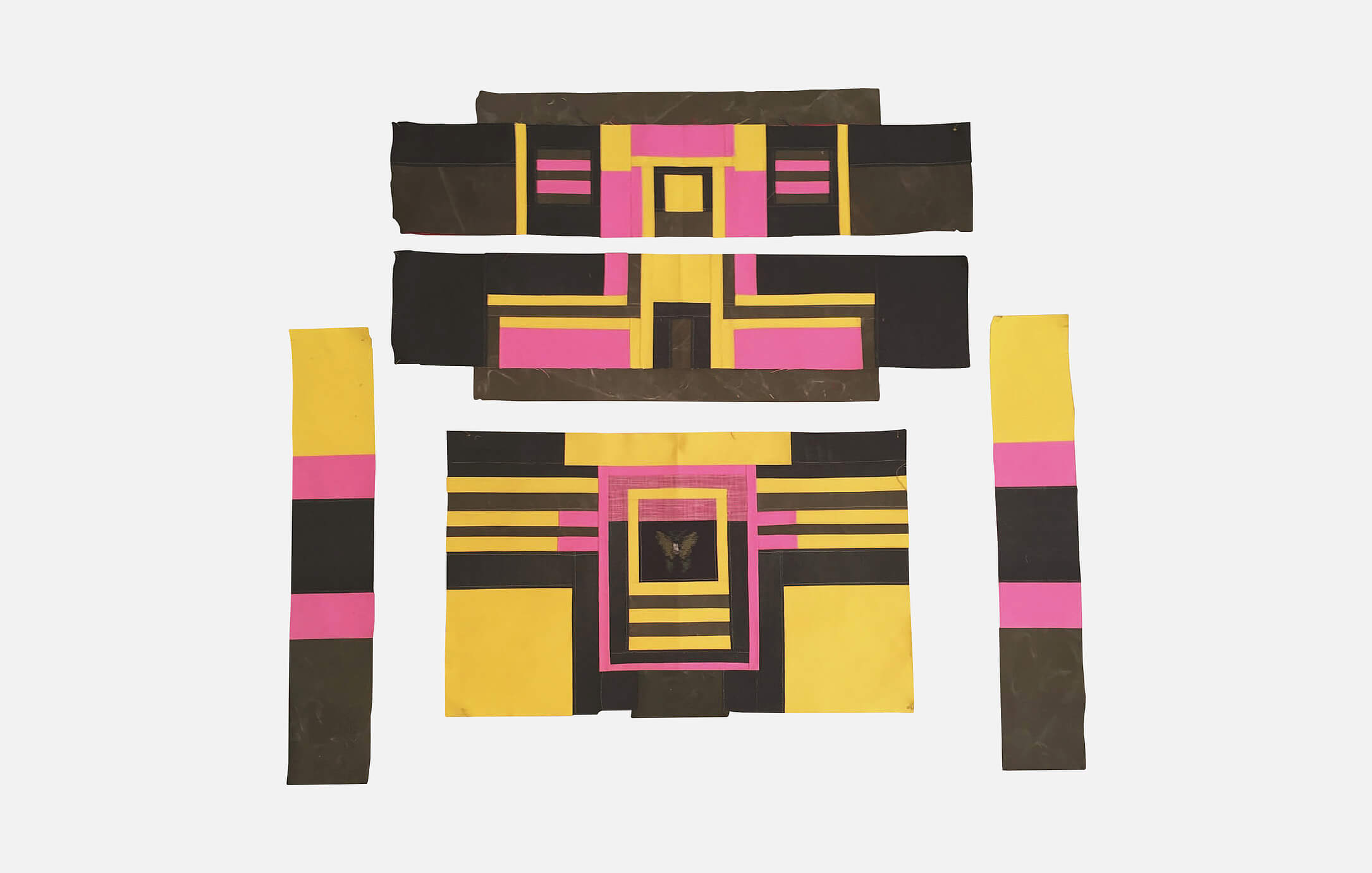
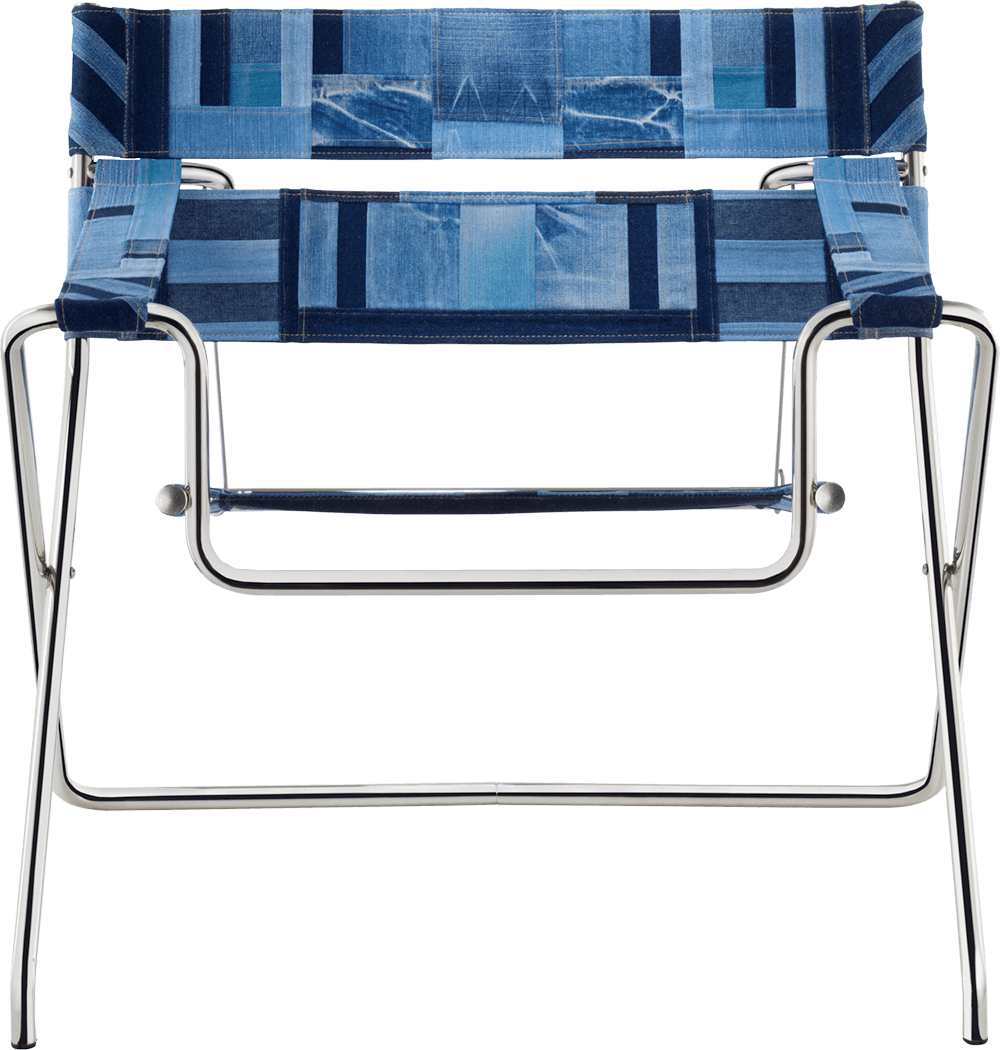
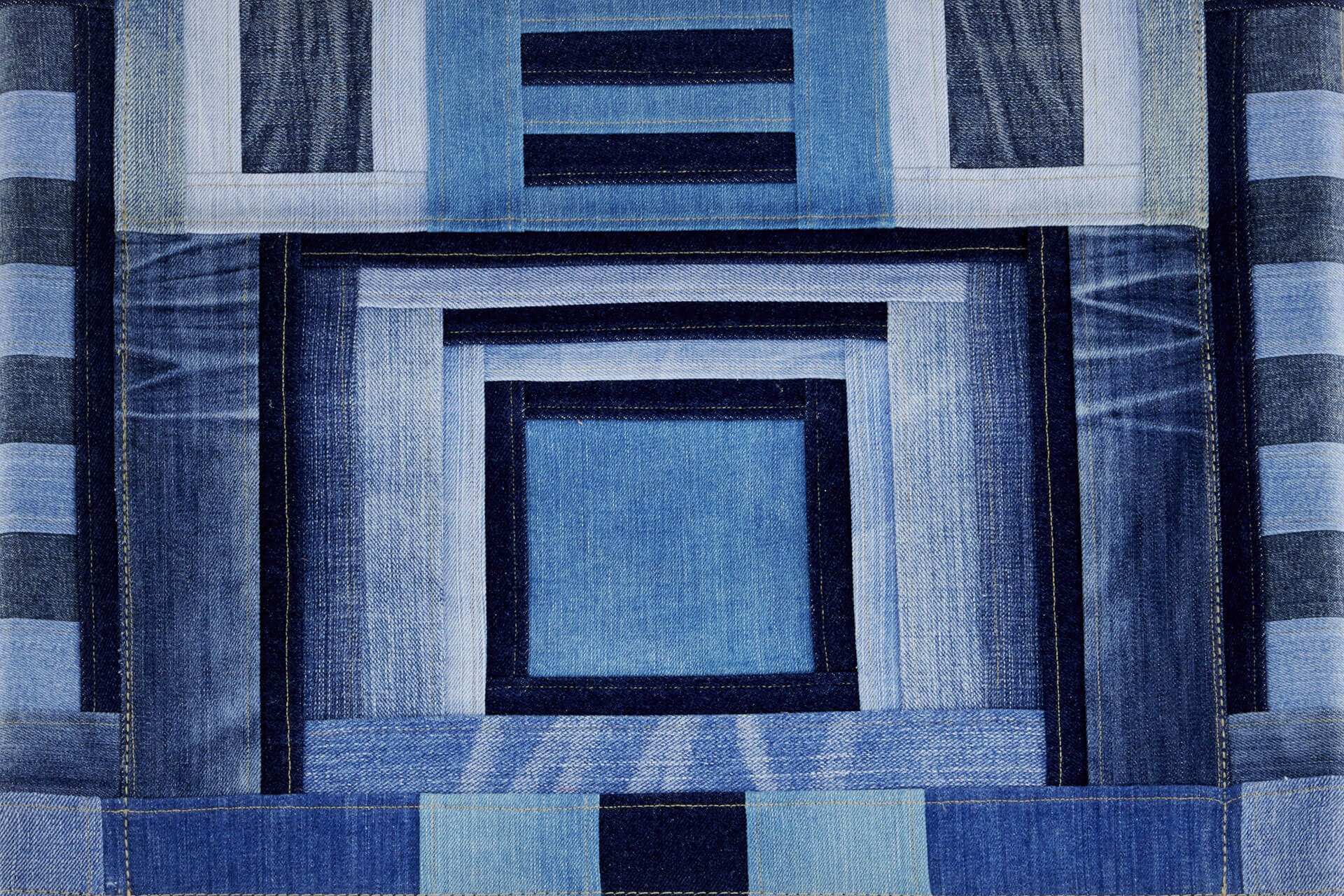
D4N
The king’s new clothes. Outfit for legends: D4 in used denim look.
An armchair to take a deep breath – and then simply let yourself be carried away in the sky blue of its legends. Breuer’s D4 club chair has been given a new outfit by artist Kerstin Bruchhäuser: The D4 in used DENIM look. Cool and sustainable – the new jeans formula for Breuer’s icon from Tecta.
+ read more
- einklappen
Few items survive fast-moving fashion trends as enduringly as jeans – for over 150 years, the trouser has been a cult. Patented by Levi Strauss in 1873, it became iconic in indigo, and for that reason alone suits Marcel Breuer’s iconic D4 from 1926/27.
Leaving out everything that is unnecessary – the collapsible tubular steel club chair was described in Breuer’s first tubular steel catalog as “particularly suitable” for terraces, summer houses, gardens and garden cafés. Modernism is tangible in it: the construction is legible, the materials perfectly matched.
A perfection that already fascinated the artist Kerstin Bruchhäuser on the occasion of the Bauhaus anniversary. Last year, she dressed the D4 in the patchwork technique of Korean pojagi, thus creating a new monument to it. Now she combines it with an outfit that weaves legends: used denim in pojagi technique. The result is a clear statement that Kerstin Bruchhäuser outlines thus: “Through the responsibly produced reinterpretation of Marcel Breuer’s classic folding chair, we show how unique sustainable design can be.”
Each of her ten unique pieces looks different – depending on the colors and washes. The light and dark blue tones tell their own stories. Whether of James Dean in the movie “… for they know not what they do” , thoughts of the blue planet, the Blauer Reiter art movement, the blue flower of Romanticism, the monochrome ultramarine blue of Yves Klein … plus greats like Elvis Presley or Marilyn Monroe in jeans.
“The possibilities of associations, color games and patterns are limitless,” says Kerstin Bruchhäuser. “Artistically, there’s always a different approach – and the connection to Marcel Breuer’s tubular steel frame looks sensationally casual.”
An armchair to take a deep breath – and then simply let yourself be carried away in the sky blue of its legends.
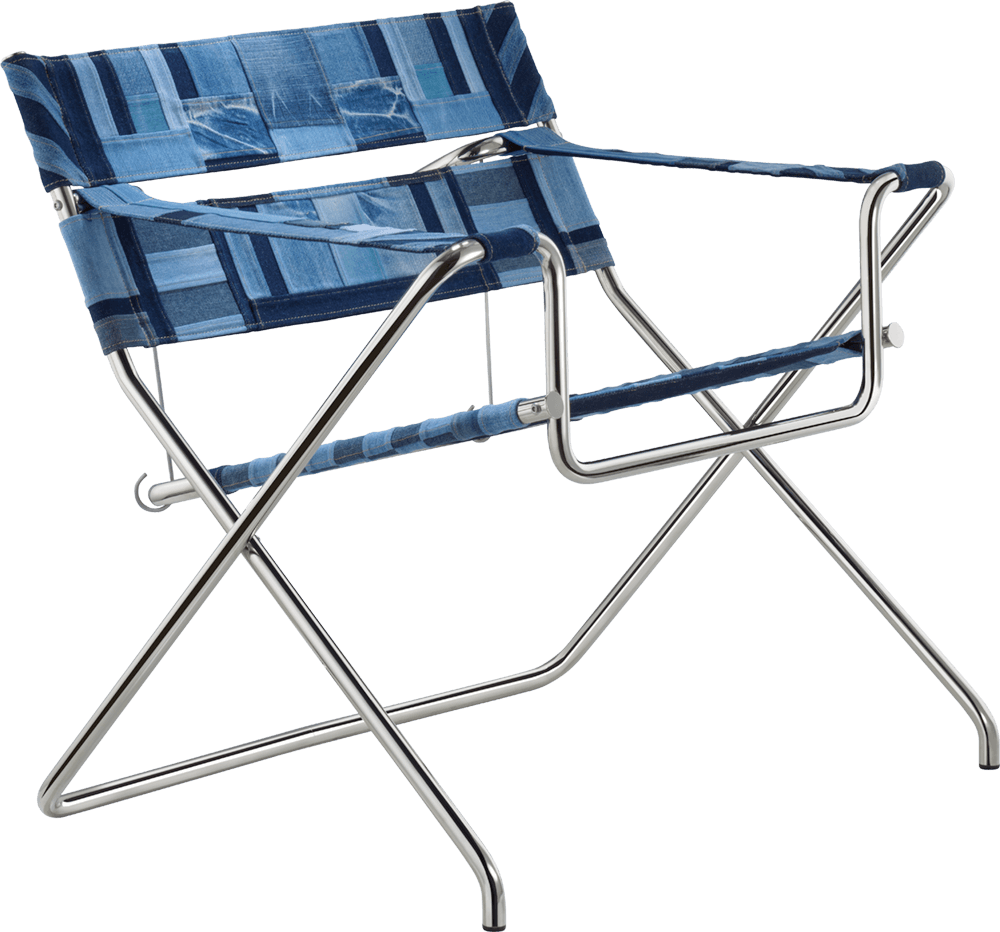
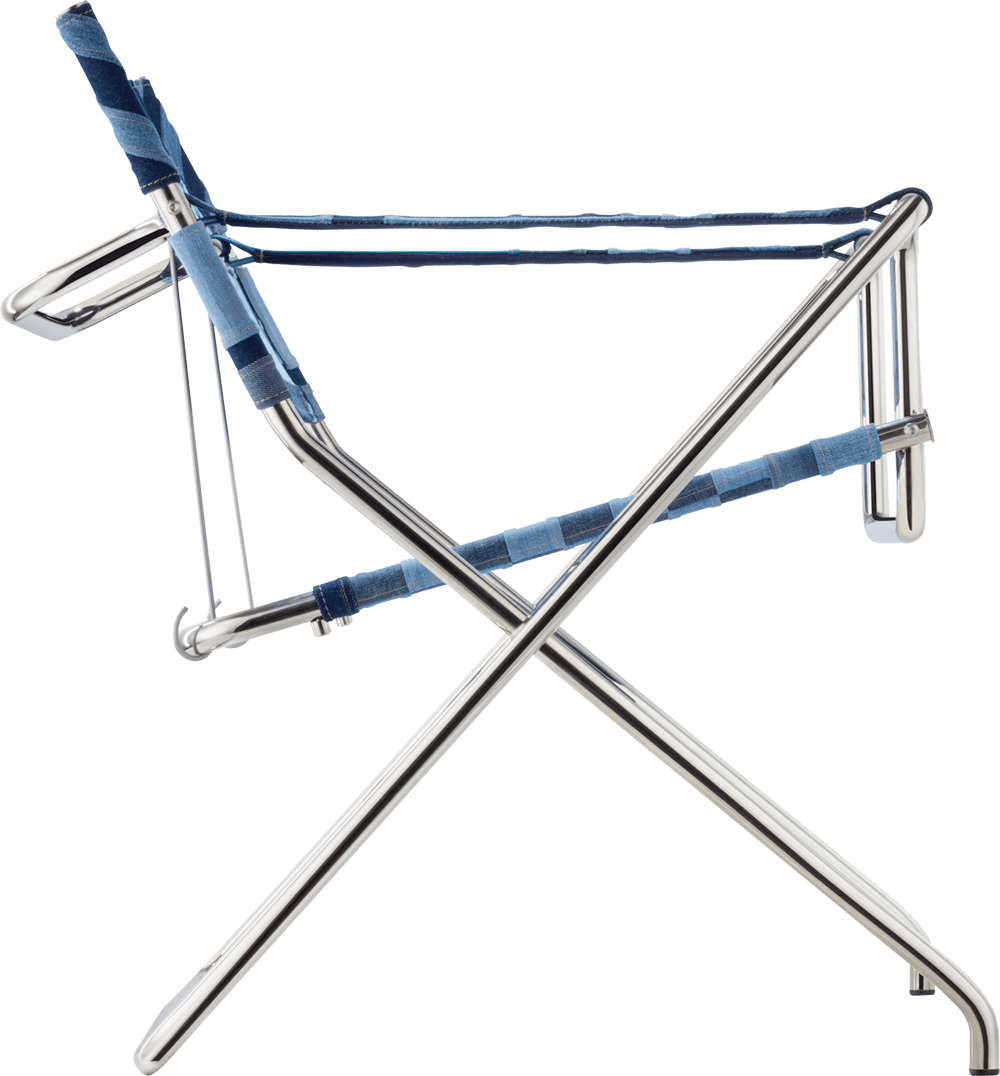

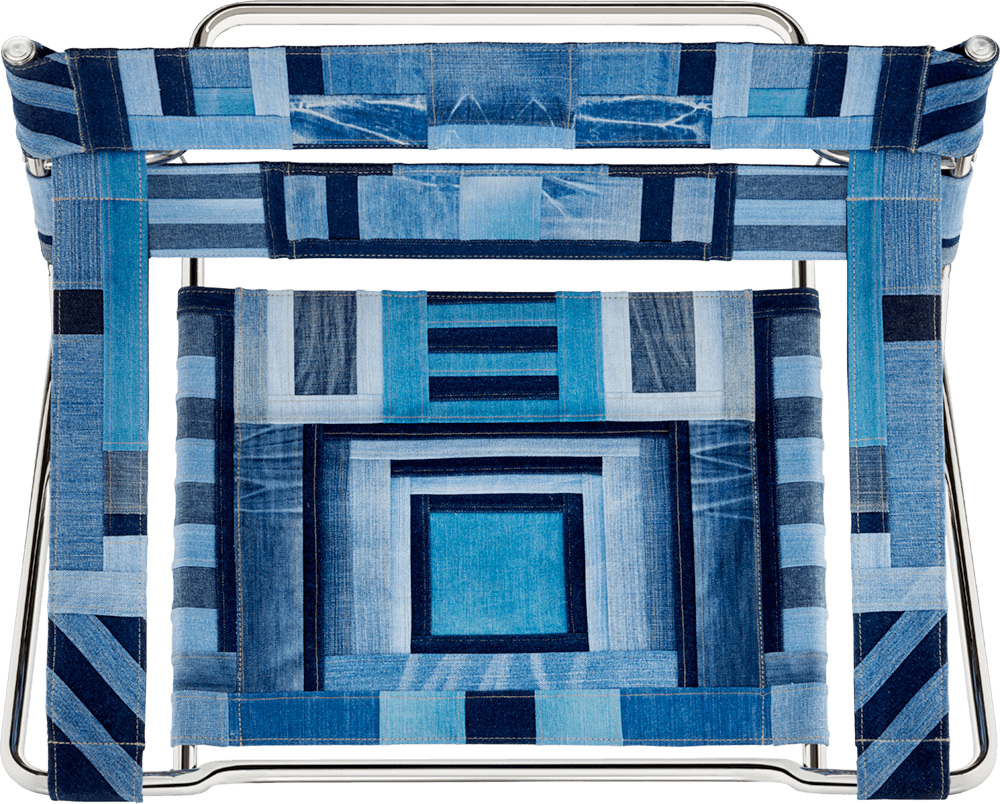
Kerstin Bruchhäuser
Kerstin Bruchhäuser, born in 1974, lives and works in Hamburg. She studied illustration and communication design at the Hamburg University of Applied Sciences from 1999 to 2005.
+ read more
- einklappen
During this time she began to create her first textile images. In 2009, she added a doctoral program in art and design at Bauhaus University Weimar, which she completed with a PhD. Her dissertation was on the topic of “Text on Used Textile in Contemporary Art.” Numerous exhibitions in Berlin, Hamburg and Weimar as well as fellowships at the Bauhaus Research School have since marked her path.
A stay in Los Angeles from 2005 to 2007 also had a great influence on her textile, artistic work, which has also met with great recognition there. In 2018, Kerstin Bruchhäuser is represented with the exhibition “The world of Frida” in Walnut Creek, California. Since 2014, the designer has also taught textile design at HAW Hamburg.
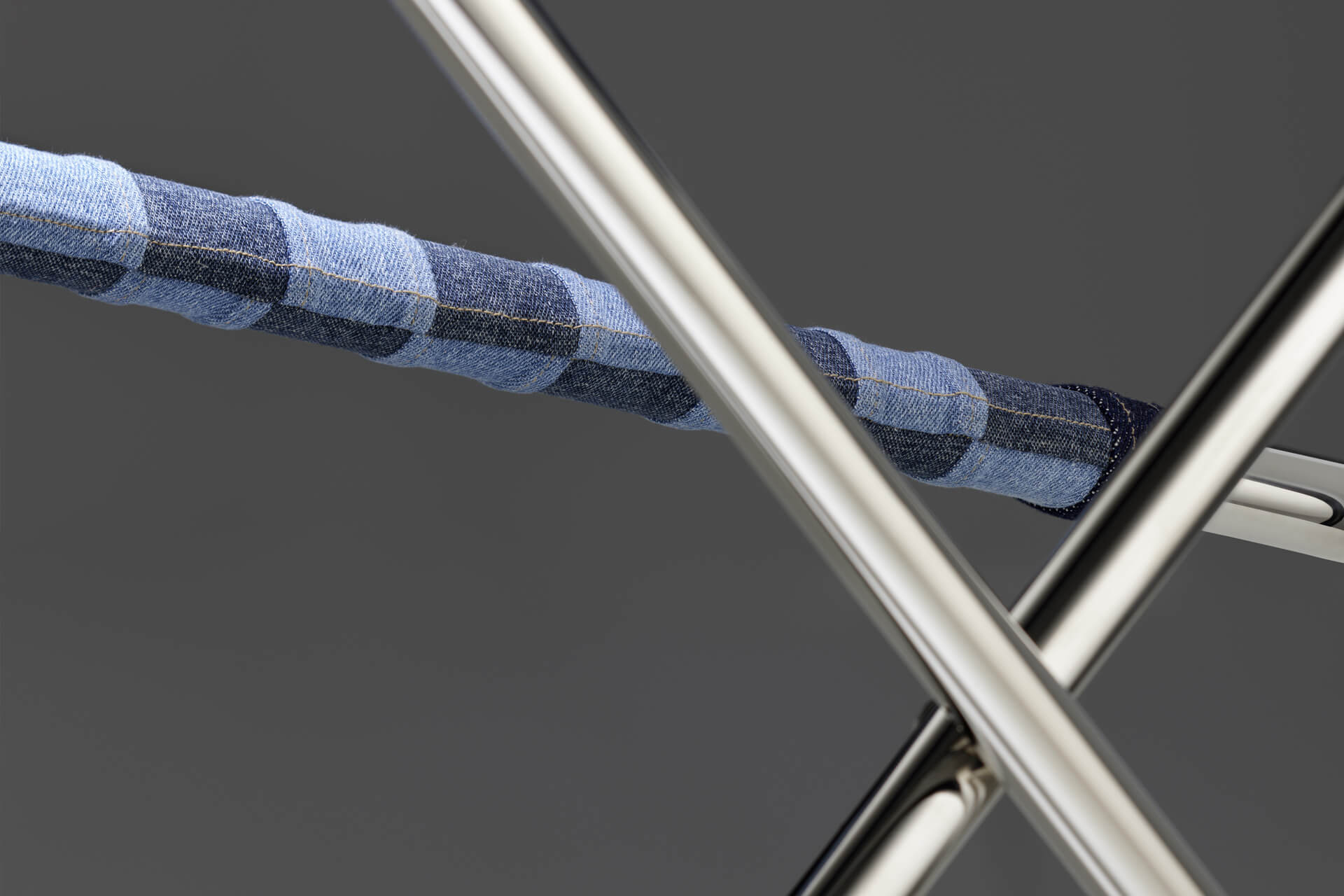
Interview Kerstin Bruchhäuser
Korean patchwork tradition meets Marcel Breuer
How did the cooperation with Tecta come about?
Kerstin Bruchhäuser: We have been in contact with Tecta for a very long time. Through a family relationship with Axel Bruchhäuser and Christian Drescher. I recently told them about the Korean Pojagi sewing technique, which I use to create large-format textile works. I sew portraits from old white linen. Christian and Daniela Drescher were very interested in this technique and visited me in my studio in Hamburg. They asked directly if I could imagine reinterpreting a Bauhaus chair with pojagi.
+ read more
- einklappen
What was the next step?
Kerstin Bruchhäuser: I chose a chair from the Bauhaus series to reinterpret: the D4 club chair by Marcel Breuer. I think the chair is cool because it’s not upholstered. You can see the front and back. That fits perfectly with the Pojagi technique.
What is special about Pojagi?
Kerstin Bruchhäuser: It’s a traditional Korean patchwork technique in which scraps of fabric are sewn together in a single layer. So the front and back sides look almost identical: The fabric pieces are joined together so that you have no open seams and no fringes. In “normal” patchwork, the back remains open – you always have to sew an additional fabric against it.
Due to the obvious seams Pojagi cloths remind of leaded glass windows, sacred. At the same time, Pojagi textiles also possess something everyday. It is a rather pragmatic use, combined with a spatial and aesthetic effect. This is because they are traditionally created from fabric scraps. So their previous life also makes the cloths very exciting and significant. Pojagi cloths are used in many ways: as privacy screens on windows or in door frames. But also as packaging to transport food. When the cloths are hung against the light, color fields are created in the room. – The aspect of sustainability plays into it in many ways – but very subtly.
Pojagi did you then simply transfer to the chair like that?
Kerstin Bruchhäuser: I discarded the first two designs when I was sewing them. The patterns didn’t fit. – Otherwise I tend to produce large-format pictures, two by three meters. That gives me more freedom of design and flexibility. If a scrap of fabric doesn’t fit in one place, you move it somewhere else, like a puzzle. But you couldn’t do that with the Breuer chair because you have very narrow places, like the armrests. I found that a lot of ideas on the seat didn’t work and the design had to be more small-scale. So on the third design, I came up with the symmetrical pattern that has now been implemented.
Were there coordination meetings during the course of the project or did you work completely freely on your design?
Kerstin Bruchhäuser: I created the pattern and selected the fabrics on my own. The seat, back and armrests were sewn by hand. A very delicate job and very time-consuming. Because the patchwork on the D4 becomes part of the chair and does not hang, the play of light naturally falls away, i.e. the effect on the room also changes. But the eye-catching seams remain. Where the fabrics are brought together, they are sometimes layered four high. This creates a multi-dimensional, relief-like seating surface.
Do you see a concrete reference to Bauhaus in your reinterpretation?
Kerstin Bruchhäuser: The Bauhaus Nowhaus project ties in with history. In my case, to the design by Marcel Breuer, which still has topicality. I take this up again through the Pojagi technique: By putting together old things, the scraps of fabric, and letting new things emerge from them. Developing something new and going back to traditional techniques is a classic Bauhaus idea.
What is it like to change a design icon?
Kerstin Bruchhäuser: It’s very ambivalent. A blessing and a curse at the same time (laughs). You have a lot of respect. Because the chair is perfect in its original form. I’ve known the D4 since I was a child. I know what Marcel Breuer was thinking.
At the same time, it is an absolute honor to be allowed to create a new approach. To have the freedom to approach this sacred piece, to be allowed to desecrate it a bit.
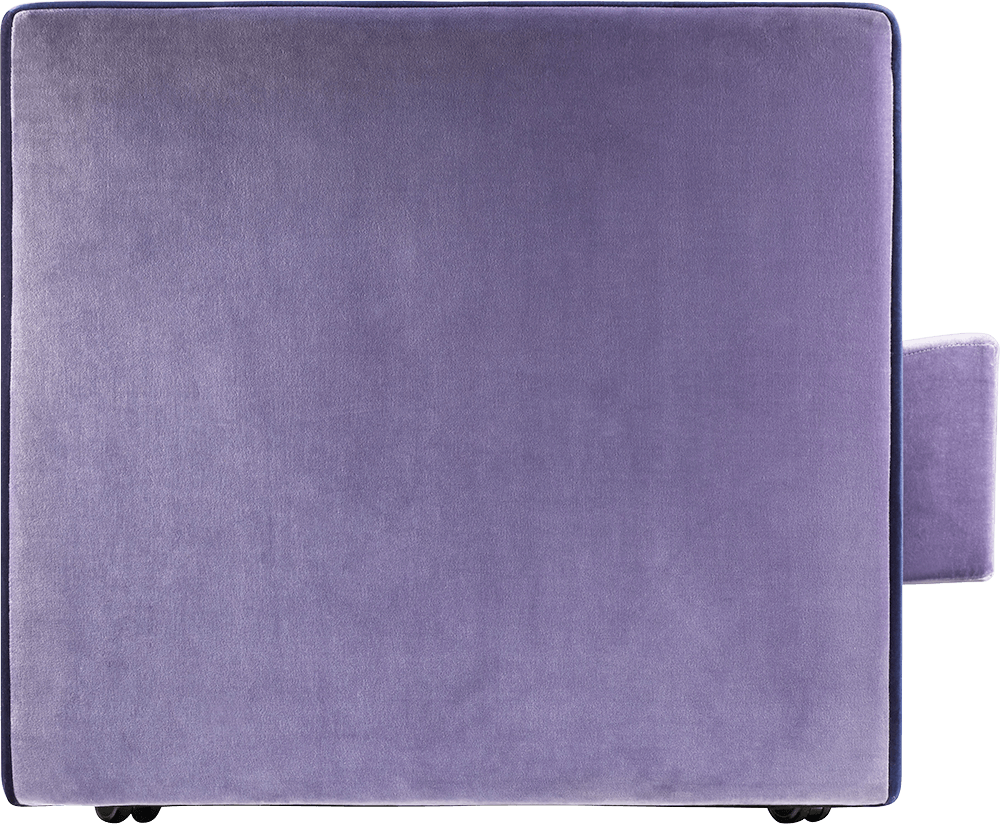
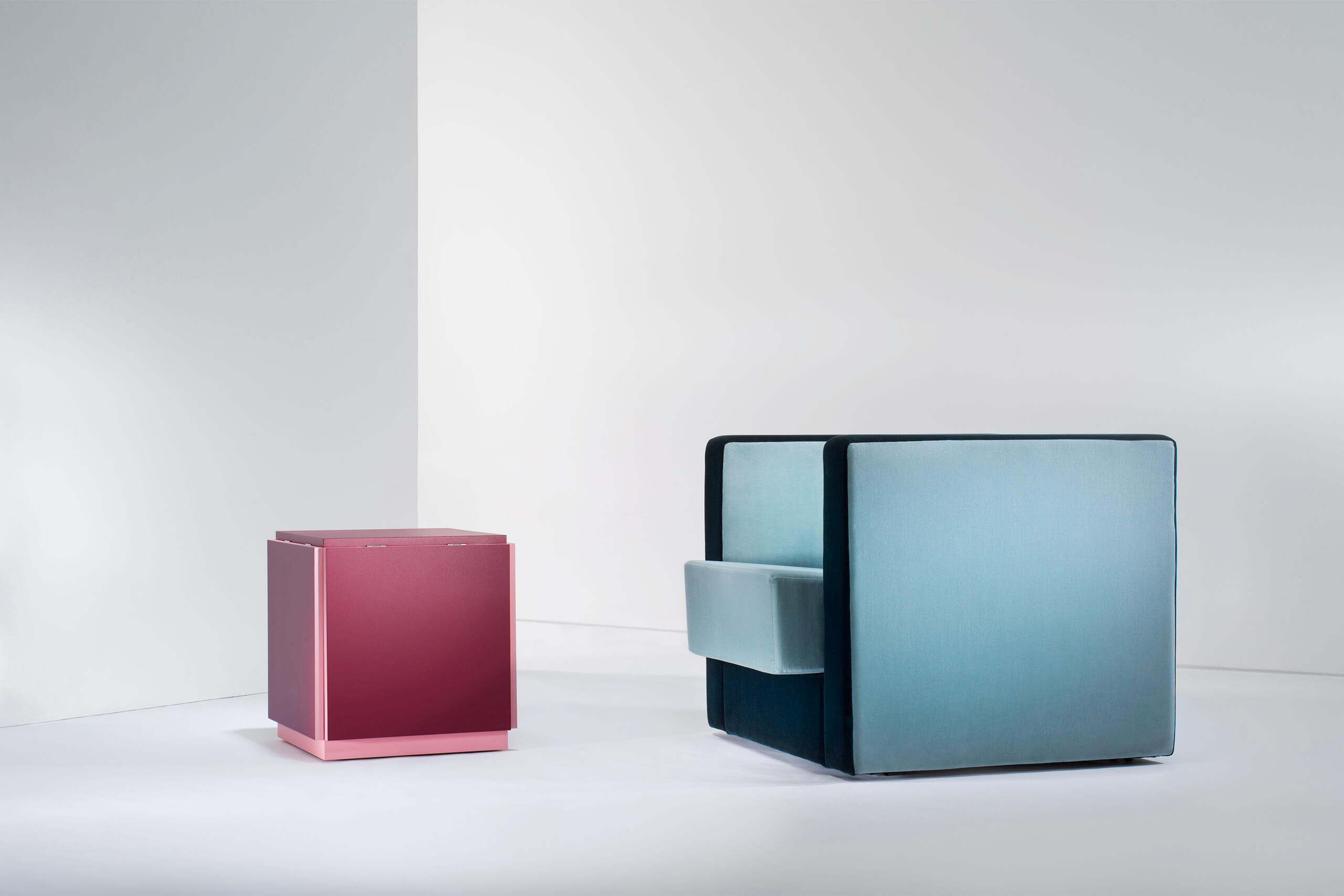
D1N
Passepartout for the seated
The radical concept behind Peter Keler’s D1 armchair instantly struck a chord with Tobias Groß. The Cologne-based designer, who also reinterpreted Erich Brendel’s tea table, has again immersed himself deeply in the world of colour. His goal: to make the D1 even more striking with a modern colour scheme. Hence, he applied darker hues to the armchair’s “frame”, while going one shade lighter for the “interior”, i.e. the seat and back.
+ read more
- einklappen
This gives the “father” of all armchairs, which has inspired entire generations of designers, a surprisingly light presence in the room. And a new impact: it looks like an aesthetically perfect frame for the person sitting in it. A frame that immerses the body in a world of shapes and colours like a picture.
The basic cube shape of the new D1 series now comes in various shades of blue and slightly lighter pastels. Its fabric, a soft cosy velvet, hugs the sitter like a warm embrace. The castors, which allow you to move and swivel the chair effortlessly, are still as intriguing as ever.
For an interesting combination, the D1 can be teamed with Tobias Groß’ new take on the Brendel table: a duo infused with fresh colours and an agile mobility that epitomises modern, contemporary living.
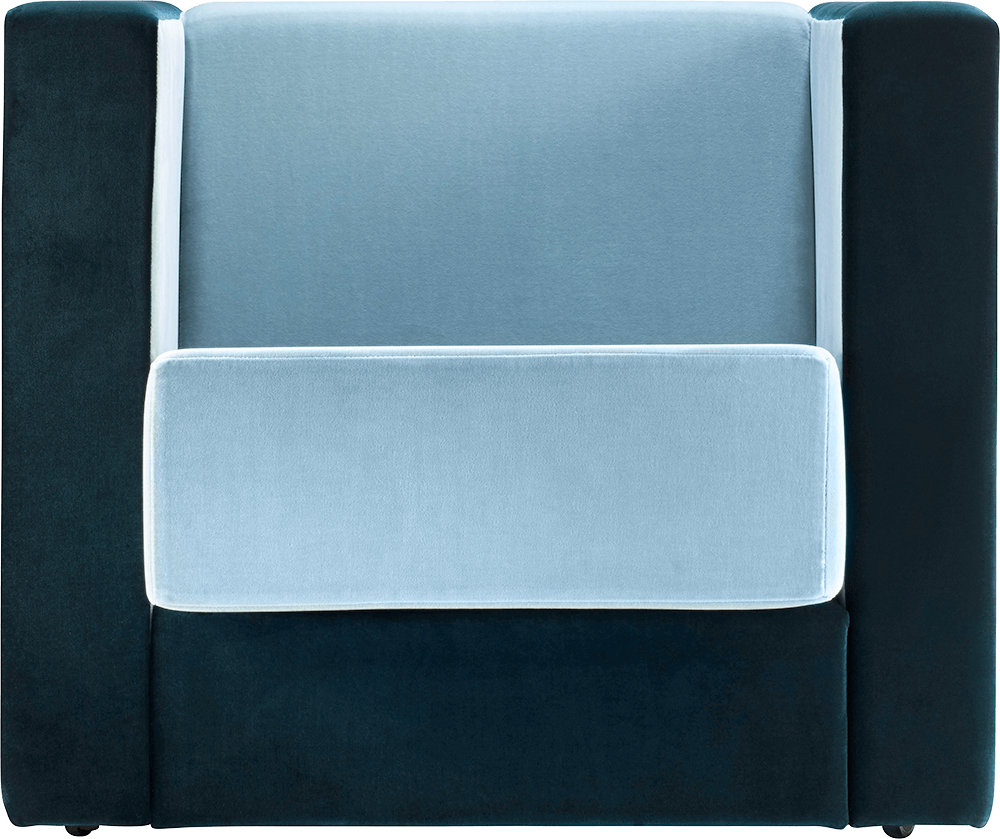
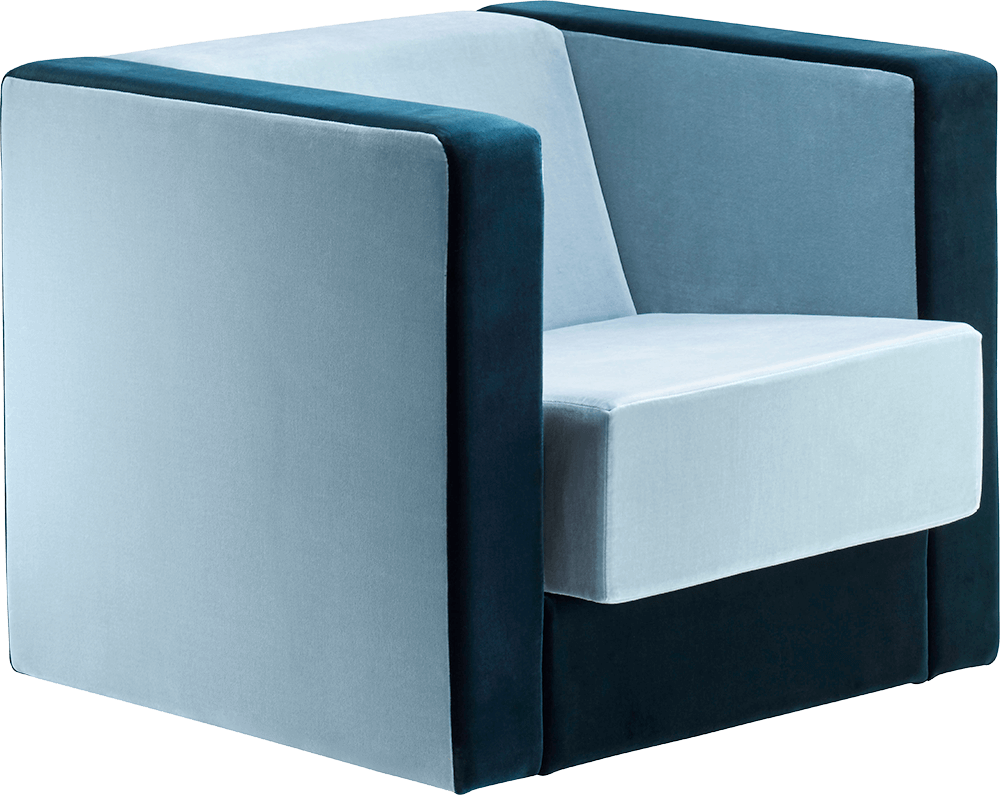
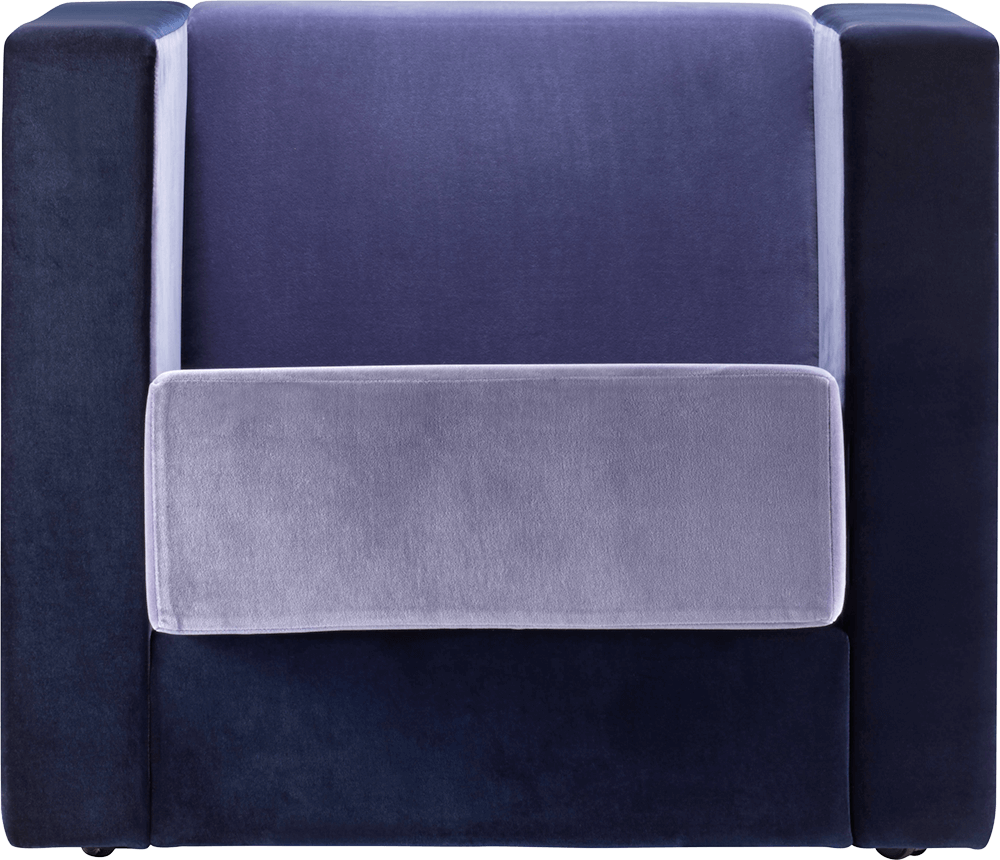
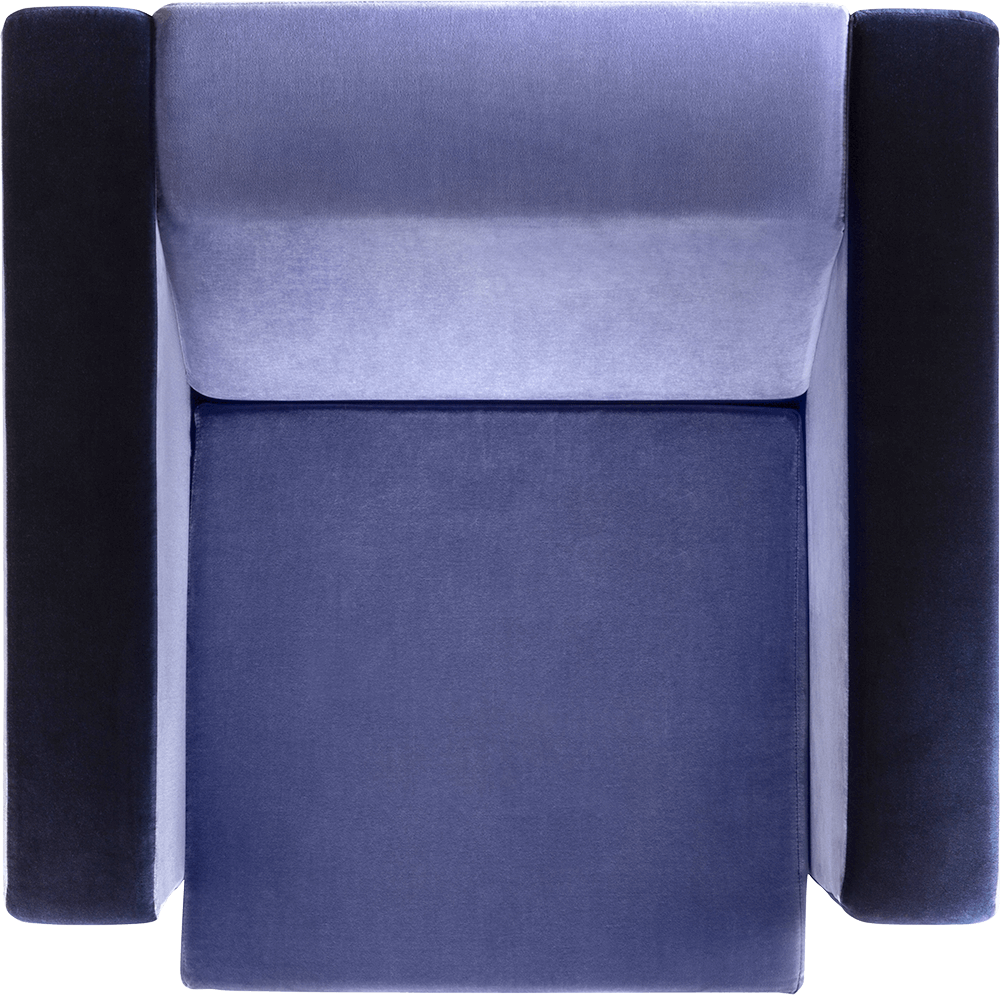
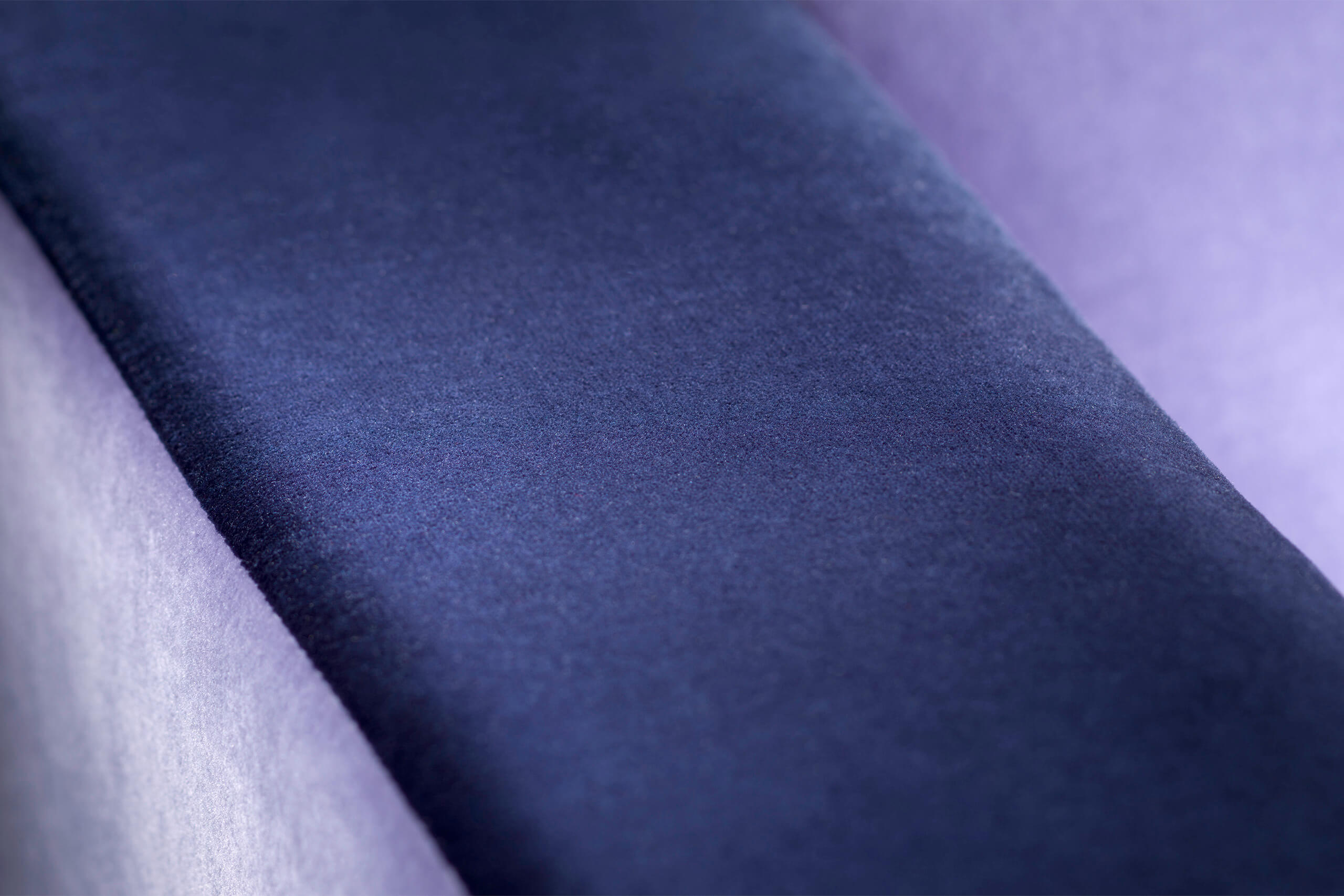
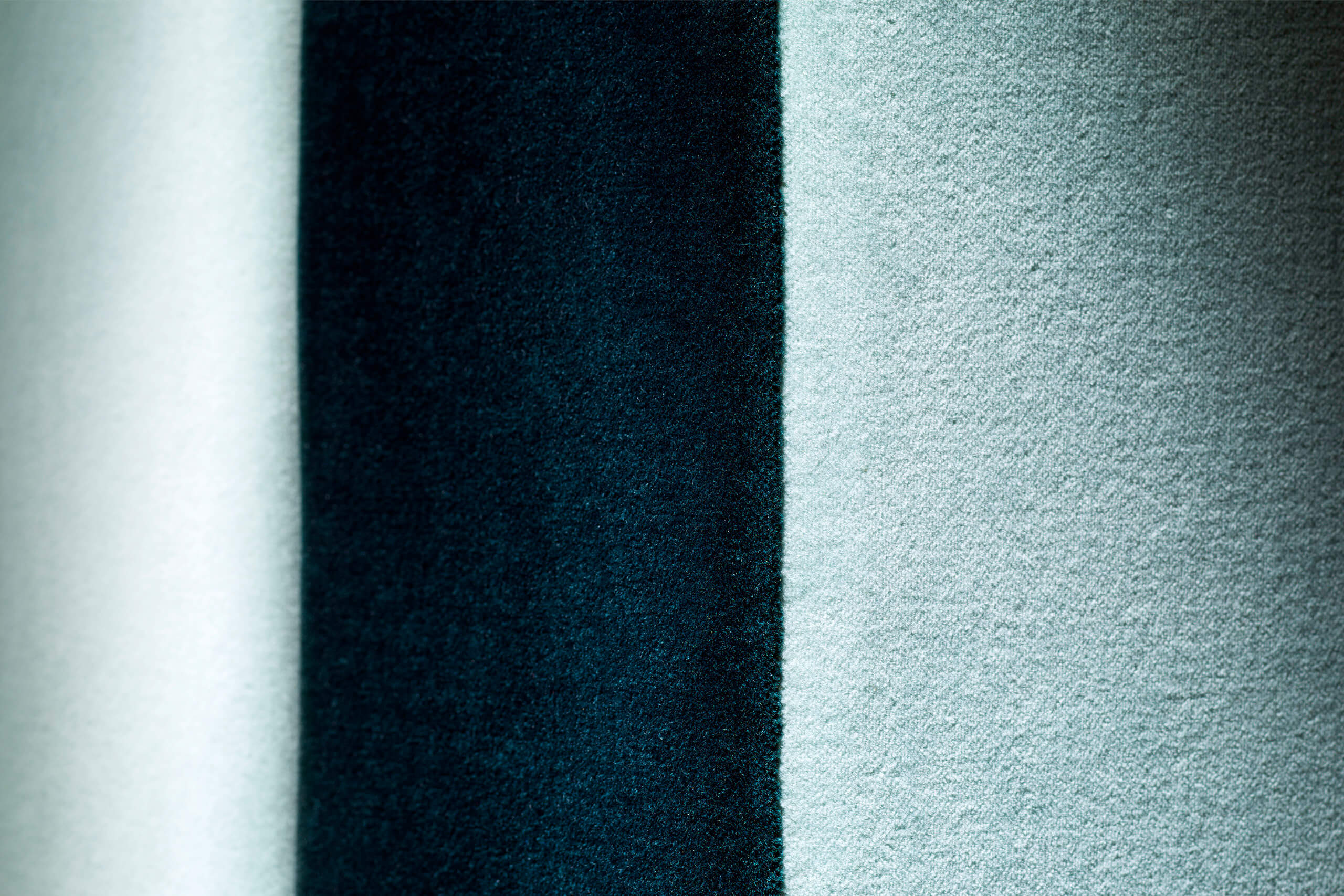
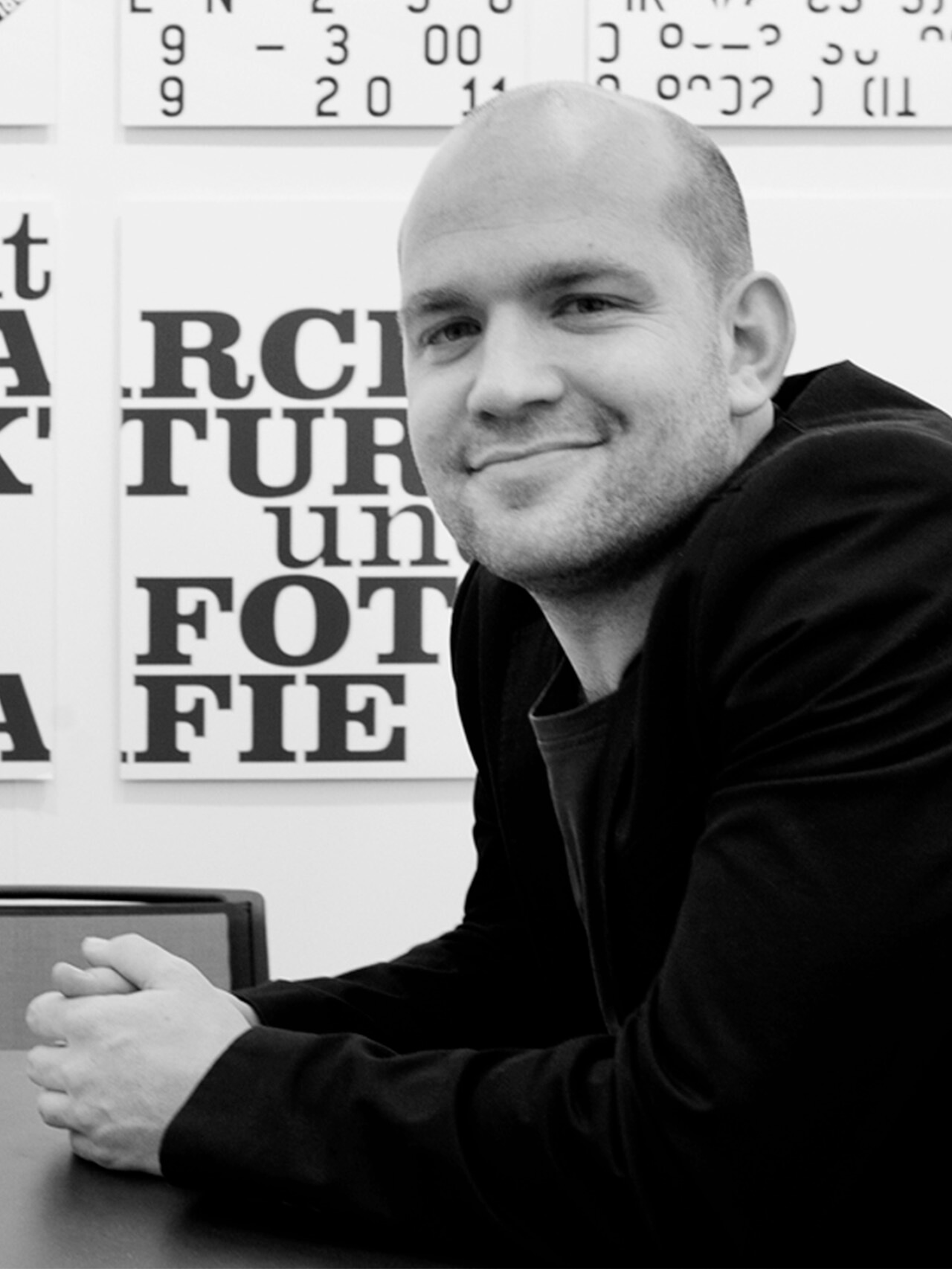
Tobias Groß was born in Braunschweig in 1976, is married and a father of two. From 1997 to 2002 he studied design at Cologne Technical University, graduating with a diploma degree in design. First place in Messe Frankfurt’s First Move Design Awards for his diploma thesis. He has been employed by a number of design agencies, including frog design California, Sunnyvale, Brand Department, in 2003. He founded his own interdisciplinary design studio großgestalten Kommunikationsdesign in Cologne in 2004, and Studio für Gestaltung in Cologne in 2018. He still works for numerous well-known clients in the field of architecture, design, art and culture today. Appointed as lecturer for information design by Rheinische Fachhochschule Köln University of Applied Sciences in 2012.
+ read more
- einklappen
About Studio für Gestaltung, Cologne:
A profound engagement with its customers’ theme worlds is pivotal to the work and projects of Studio für Gestaltung in Cologne. “Our mission is to think forward the attitude and products of our customers,” says agency owner Tobias Groß. “Communication as an extension of the client’s identity.” Team spirit, and an open and interdisciplinary approach are part of the agency’s philosophy. For seven years the studio has also been responsible for communicating the Tecta brand. The minimal but colourful design of the catalogues, brochures and exhibition booths reflect the company’s decision to actively think the Bauhaus forward.
Today, over 50 national and international awards bear witness to the high quality of Studio für Gestaltung’s work. They include: The Most Beautiful German Books, 100 Best Posters, Red Dot Communication Design Award, Design Award of the Federal Republic of Germany, iF Communication Design Award, ADAC Award.




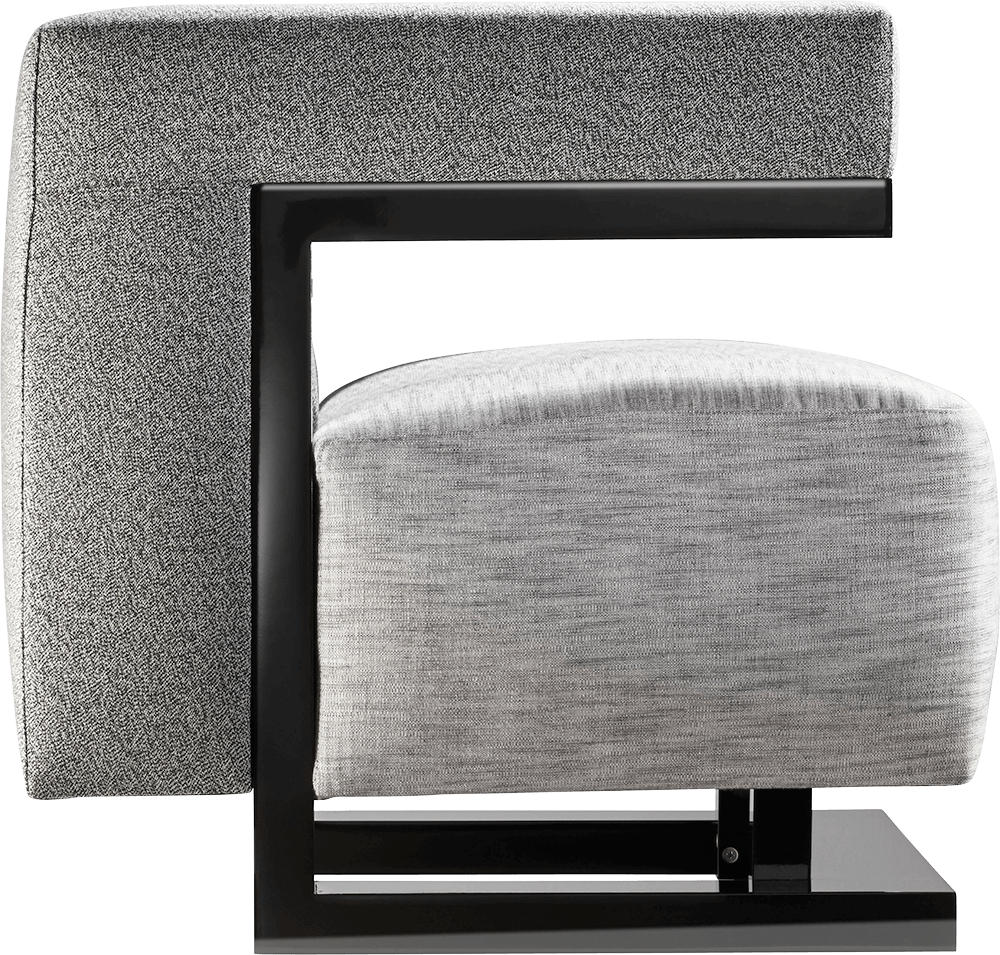

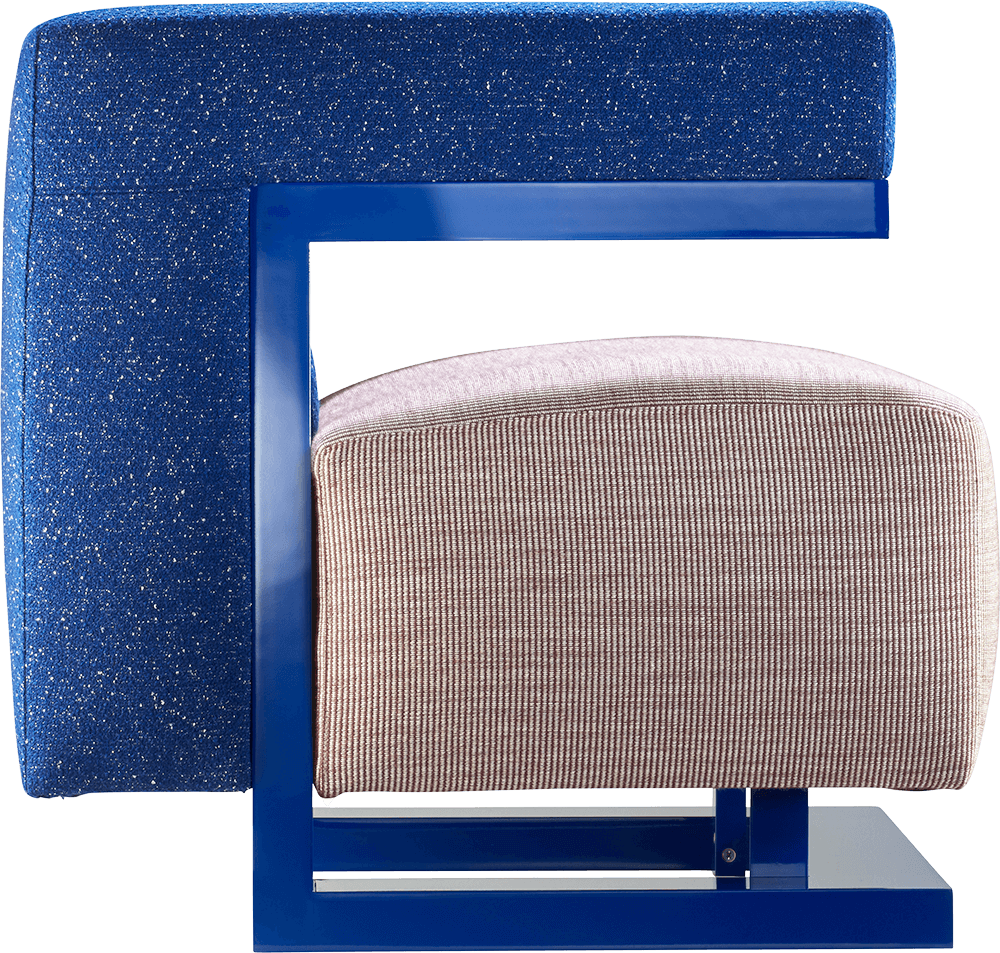



F51N
2019 & 2023
Gropius’ new clothes
It was the Roaring Twenties and there was something in the air: “Defying gravity and overcoming the earth’s inertia, in impression and appearance,” was the aim of Bauhaus founder Walter Gropius. Like the cubic cantilever design of his F51 Director’s Chair, these prophetic words stood for a new chapter of modern seating: the cantilever concept. The armrests of the F51 protruded freely and even the back of the chair did not touch the ground. A piece that embraced Lissitzky’s vision and was considered an innovation.
+ read more
- einklappen
For her new take on the F51 Katrin Greiling demonstrates how to rethink the iconic chair’s surfaces and colours. She presents the Gropius armchair in striking colour and texture combinations that change perspectives and draw attention. In doing so she has given the F51 a new face after 100 years. The fabrics she uses for this purpose were created by the Belgian fashion designer Raf Simmons for Kvadrat. Inspired by wool, twill and tweed, the collection features textures and colours that enable a transition to contemporary furniture.
Katrin Greiling divides the armchair into three design areas: frame, seat and armrest upholstery. She presents the distinctive geometrical wooden frame in six new colours realised with a high-gloss lacquer. Colour plays a major role in all her designs, and the same goes for the F51. She draws attention with colour and textures, emphasizing shapes and proportions. A primary source of inspiration for Katrin Greiling’s design approach to the task was the textile artist, Gunta Stölzl, director of the weaving workshop, whose importance to the legacy of the Bauhaus has often been overlooked. The F51 by Katrin Greiling is a marriage of geometry, colour and texture that skilfully connects the past with the present.

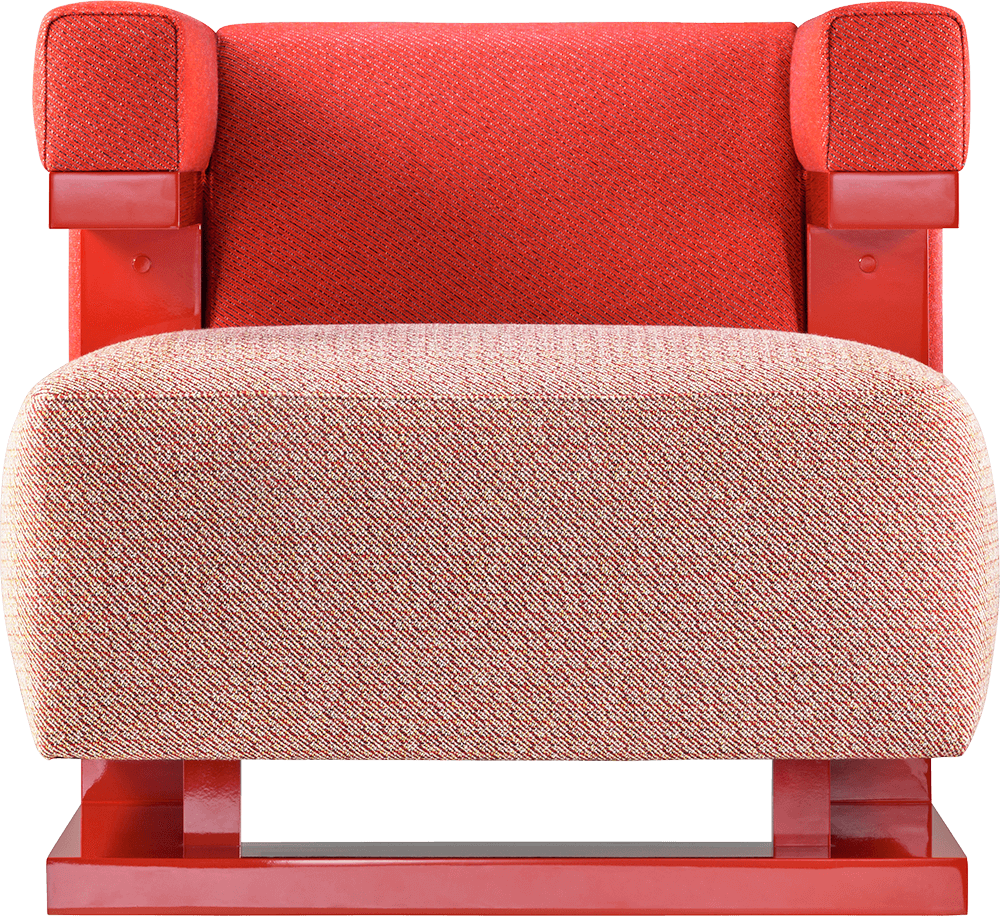
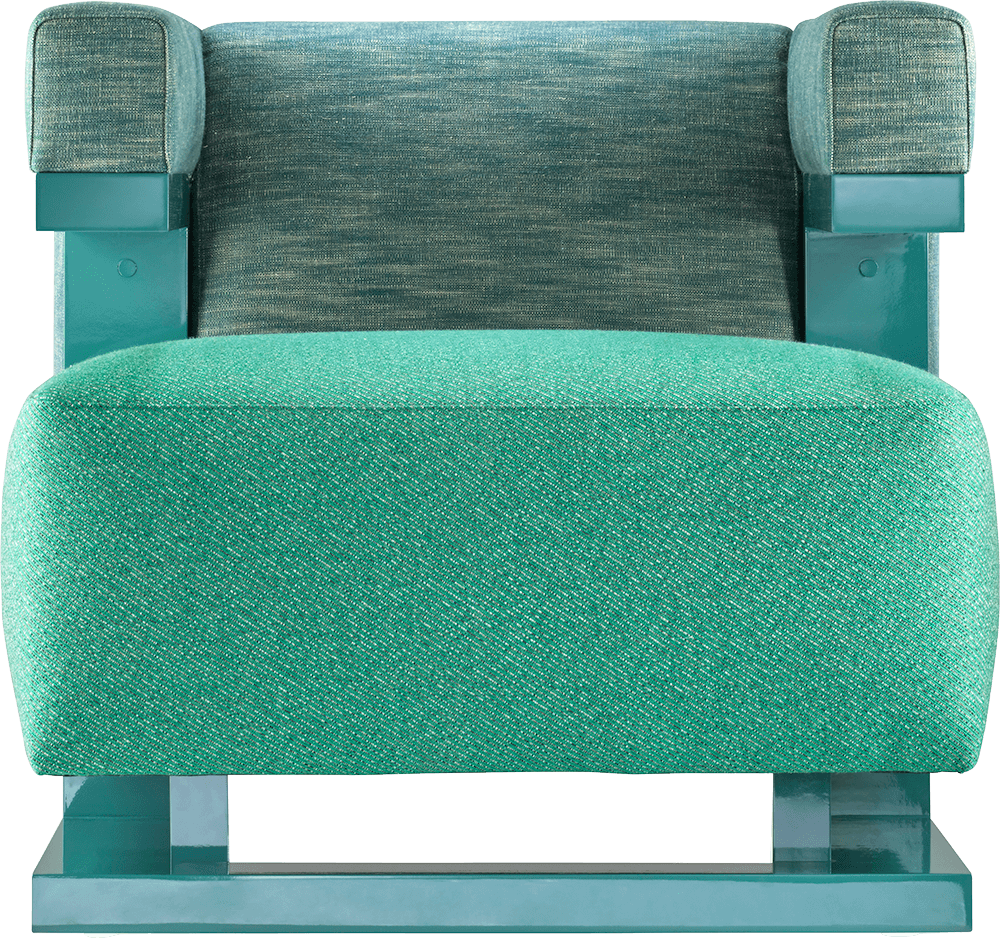

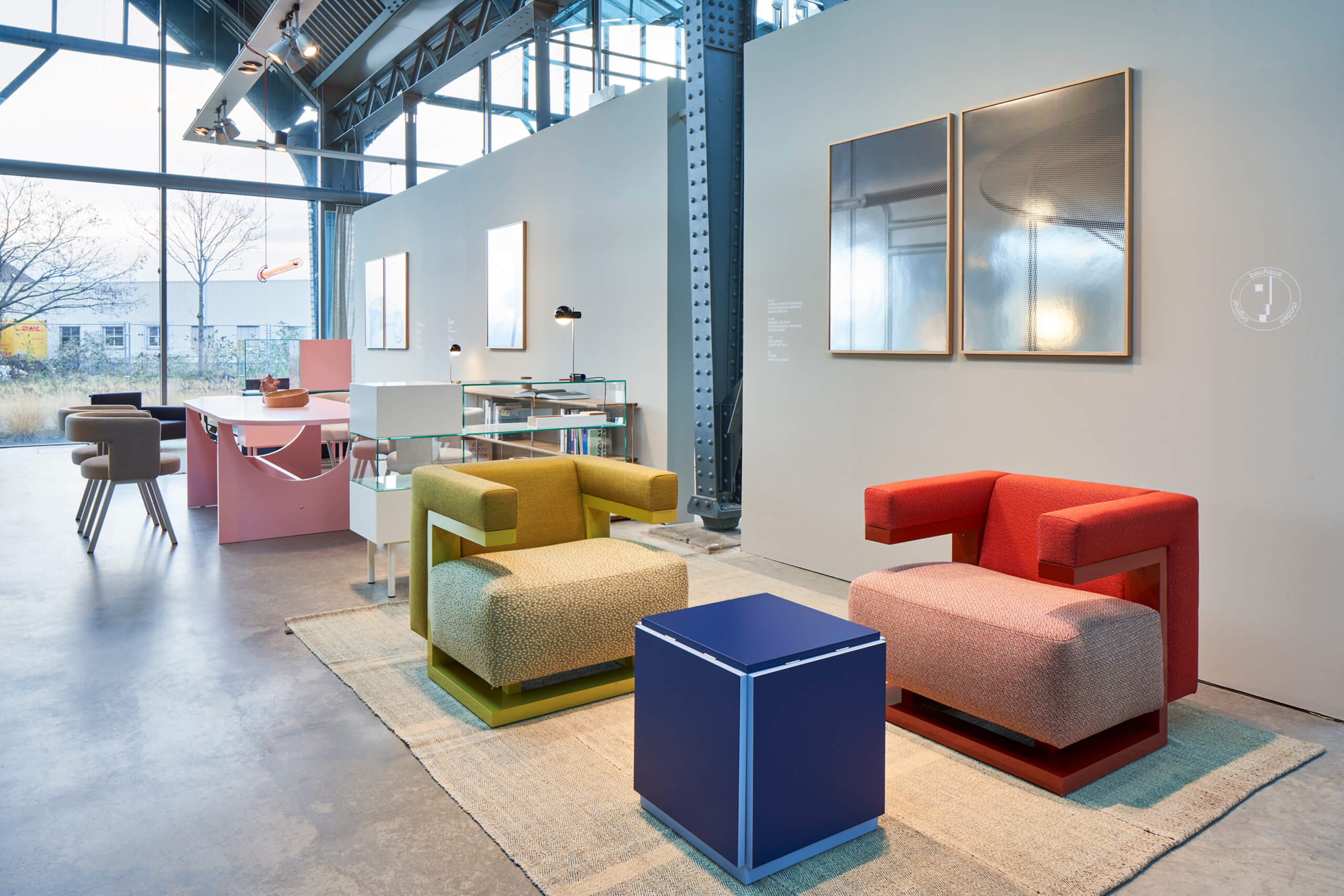

Born in Germany in 1978, Katrin Greiling left for Sweden in 1998 to study cabinet making and fine carpentry at Capellagarden. She continued her education with a 5 year master’s degree in furniture design and interior architecture at the prestigious Konstfack University in Stockholm. After graduating she started on a quest to explore design globally: During a three-year stay in Dubai she was commissioned to design global offices for a property developer. Research trips took her to Shanghai, Cairo and Istanbul. She studied the culture of the Middle East. Some important works were created during this period, including the Bidoun Sofa Series, consisting of stacked mattresses inspired by the daily life of traditional Bedouins.
+ read more
- einklappen
In 2013 she moved Studio Greiling from Stockholm to Berlin, Germany. Her work combines Furniture Design, Interior Architecture and Photography – an interdisciplinary mix, which enables her to tackle her projects from a variety of perspectives.
Studio Greiling’s creations have won numerous design awards and participate in many international projects and exhibitions. In 2010 she was featured in the first Wallpaper Handmade exhibition by the UK’s Wallpaper magazine. In 2012 she was one of the designers selected for the Halingdal 65 show by Kvadrat. Together with Etienne Descloux she developed the “Freunde von Freunden” x Vitra apartment in 2014 – a showroom and event space in Berlin. Her most recent collaboration was with Kinnasand. It took her to Milan for the Structures exhibition in April, 2018, which explored the interface between carpet and object.
In 2017 Katrin Greiling was appointed to the position of Professor of Product Design at University of Fine Arts in Saarbrücken.
Interview Katrin Greiling
Into the 21st century with colours and textures
What inspired you to give the legendary F51 by Gropius a new outfit?
Katrin Greiling: In autumn 2017 I started a project at HBK Saar with the question: How do the companies that inherited the Bauhaus legacy work with it? How do they create something new out of this heritage? I wrote to Tecta asking if they were interested in working with a university. And so a wonderful project was born, which gave me the opportunity to get to know the company and the people behind it. When we met again at imm Cologne in 2018 Christian Drescher asked me if I wanted to develop a new edition of the F51 chair by Walter Gropius.
+ read more
- einklappen
What were your first thoughts about changing the F51?
Katrin Greiling: I asked myself: How would I see the armchair in the context of contemporary furniture? I didn’t want to create a new design but rather to re-interpret and re-define the given framework of surfaces, textures and colours.
What aspect was key for your concept?
Katrin Greiling: The body of the F51 can be perceived in different ways. It consists of wooden and padded surfaces. The question that interested me was: Should one separate these surfaces with contrasts or combine them harmoniously? Colour plays a key role in all of my designs. Colour allows you to draw attention, emphasise proportions, highlight or restrain shapes. I have long been a fan of the works of textile artist Gunta Stölzl. She was a contemporary of Walter Gropius and director of the weaving workshop, whose importance to the legacy of the Bauhaus has often been overlooked.
Was it Stölzl’s works in particular that gave you further inspiration?
Katrin Greiling: Gunta Stölzl’s art inspired me to continue working with monochrome and patterned surfaces, the texture of the woven fabric and a more nuanced choice of colours. As a contrast to the tactile Kvadrat fabrics, I chose a high-gloss lacquer for the wooden elements of the armchair, concealing the structure of the underlying material. The source of inspiration for this was traditional urushi lacquerware from Japan. The materials provide stark contrasts that merge into a balanced piece of furniture.
Why did you use fabrics by Kvadrat?
Katrin Greiling: I like Kvadrat’s use of colour, material and tactility. I have been working with the Danish company on various projects for many years and I know their collections. I already had some of the fabric samples in my studio, and after talks with Kvadrat I made my selection for the new edition of the F51.
Is there a connection between your work and the Bauhaus idea?
Katrin Greiling: The crafts-based approach plays an important role and sets the tone for later designs. In teaching I attach great importance to an understanding of materials and construction. My own education followed a similar path; before studying furniture design in Stockholm I trained as a cabinet maker for two years. Like at the Bauhaus, the workshop was my workplace.
Is there anything you can improve in a classic?
Katrin Greiling: The F51 is an icon, so it was never a question of changing the basic structure, but rather one of focusing on the contrast between the soft padded and hard structural surfaces. I took the chair apart and explored the question: How can I modify this precise given framework? It is an attempt to take the chair out of time and make it part of a contemporary setting in a manner that defies the fact the F51 is a 100 year-old design. The important thing was not to change the basic structure of the easy chair, so that it can still be manufactured by Tecta in its regular production flow, respecting the history of the piece and the work it takes to produce it today.
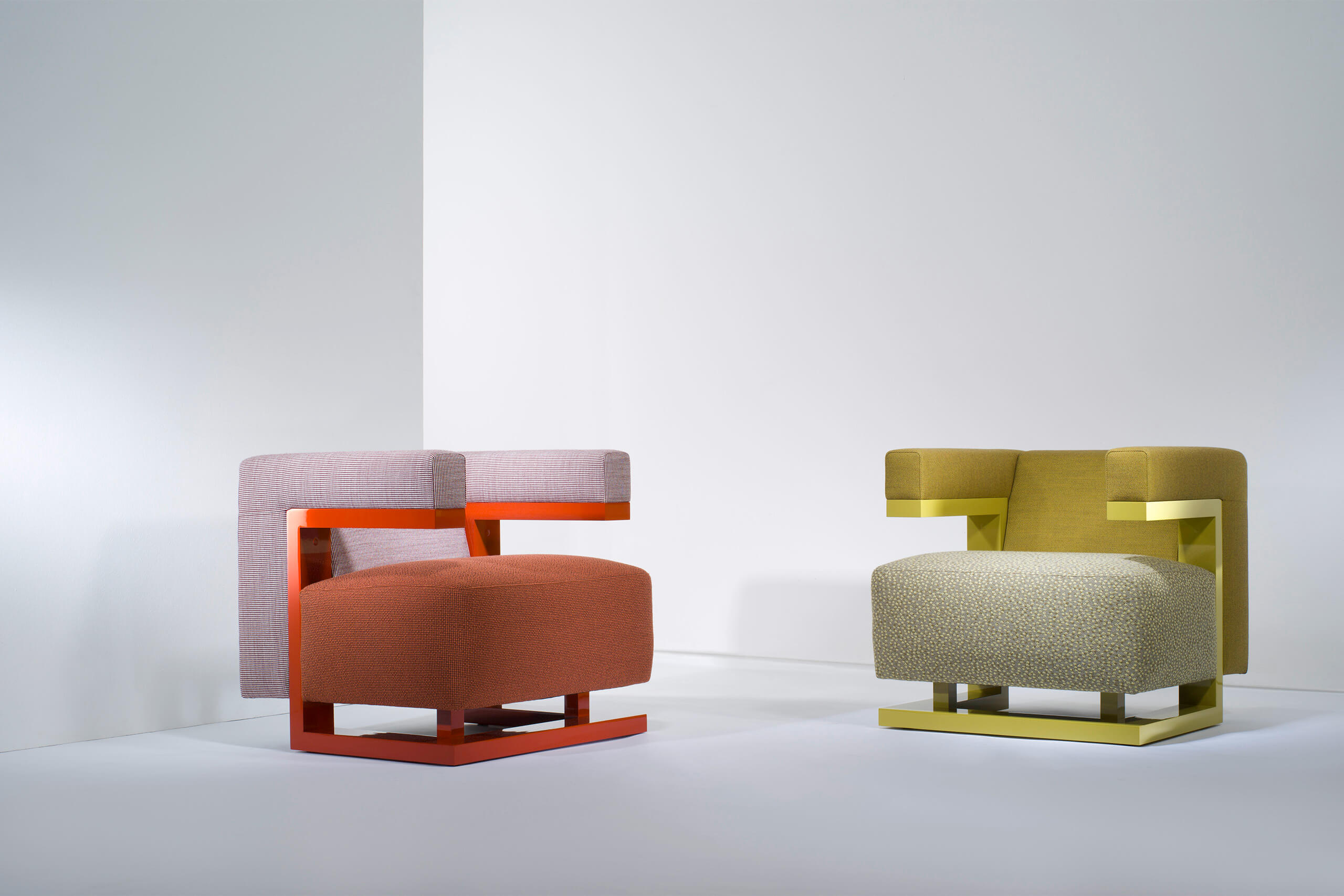
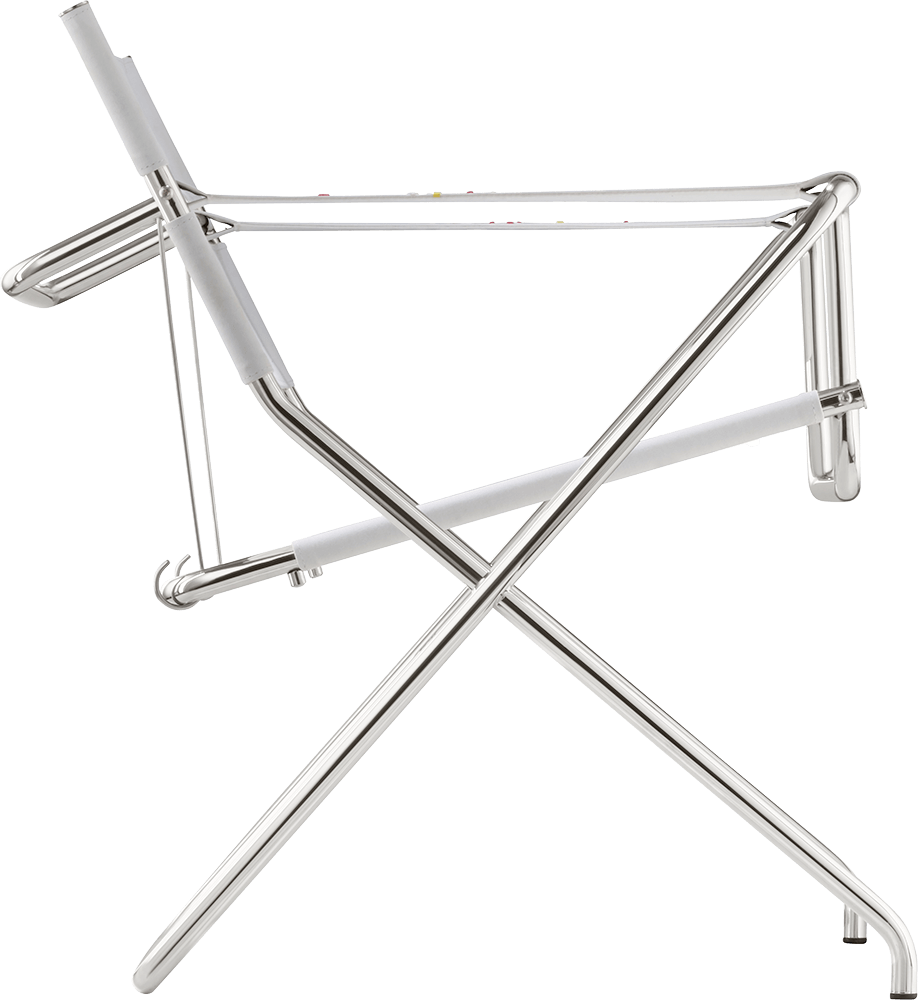
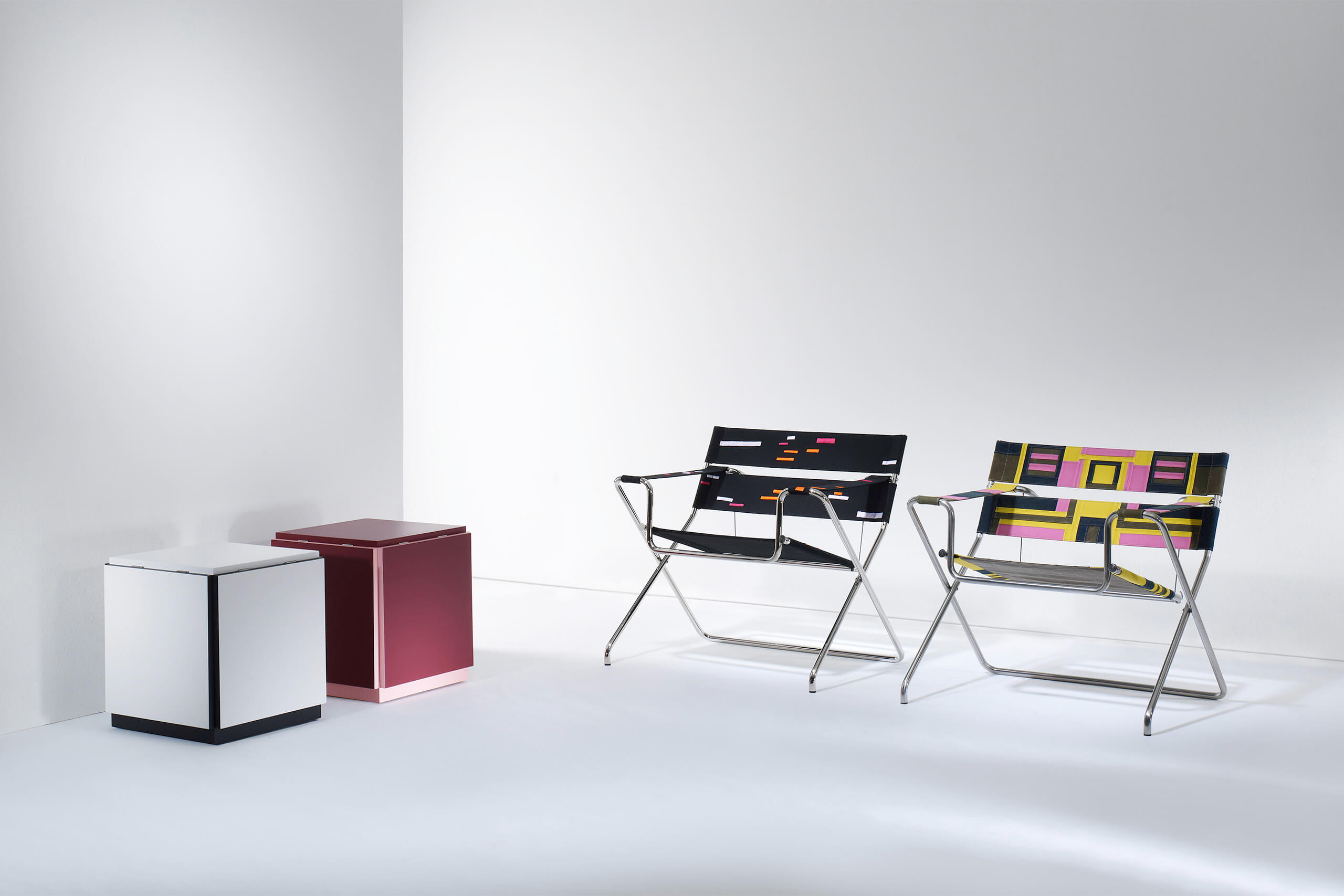
D4N
Bauhaus text as poetry in stitch
The D4 is a timeless classic with its own special magic, and a chair that British designer and artist Esther Wilson grew up with. It brings back memories of her grandparents, the architects Alison and Peter Smithson, who owned a D4 and collaborated closely with Tecta.
+ read more
- einklappen
Designer Esther Wilson, who is a trained embroiderer, has therefore created a poetic thought work that pays homage to Breuer’s chair and the Bauhaus. She based her new edition on the Bauhaus Manifesto in its original layout. On a copy Wilson highlighted several words and hand-written notes, which she considered important, in different colours.
According to their positions in the Manifesto, she embroidered the resulting colour blocks onto the textile surfaces of the D4. And in doing so created intense, minimal pieces of embroidery. Works of art with a unique rhythm of arrangement and colour repetition. The sizes and proportions of the colour blocks vary according to the chair style – Wilson has customised the pattern to scale for each version.
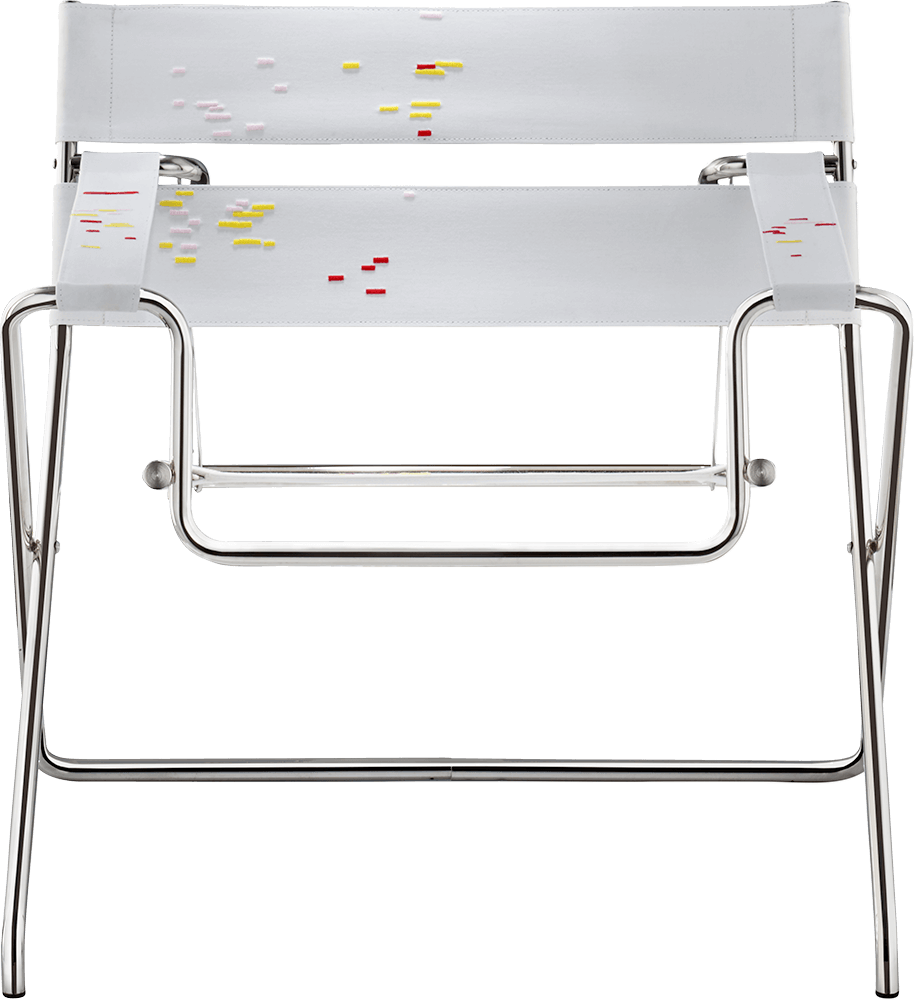
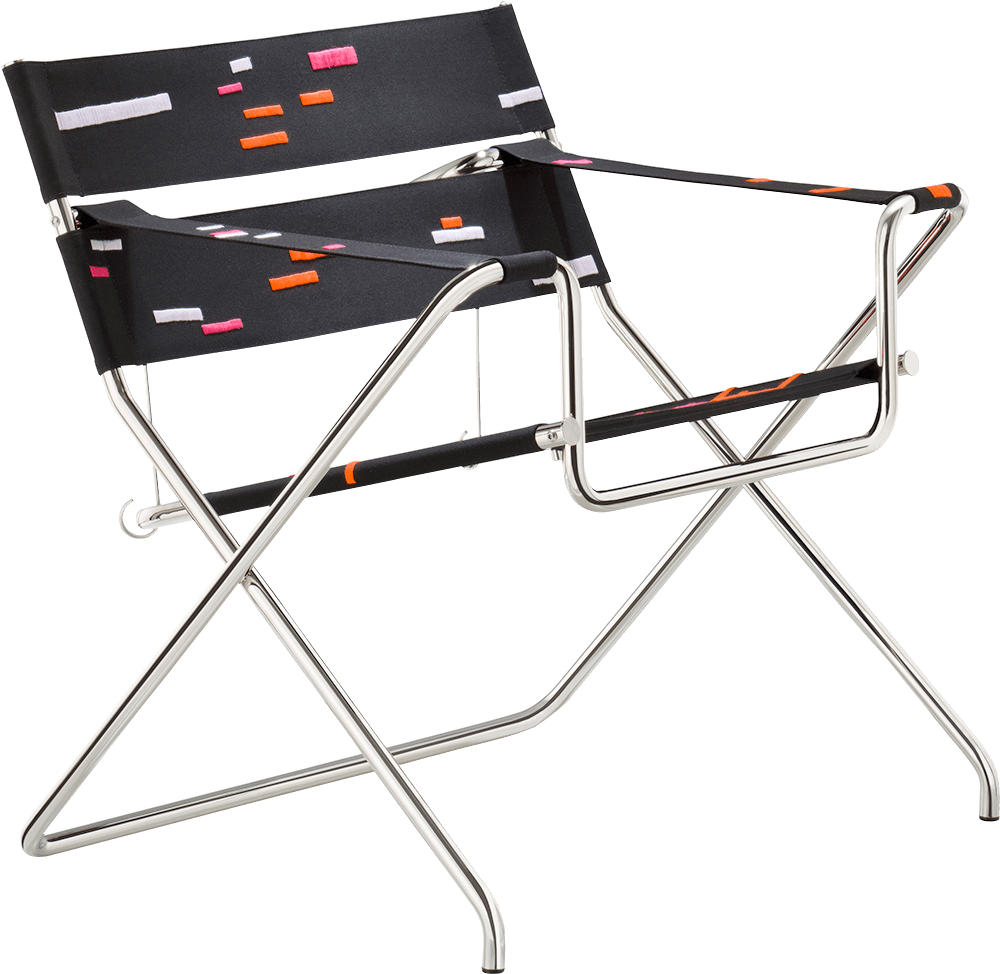
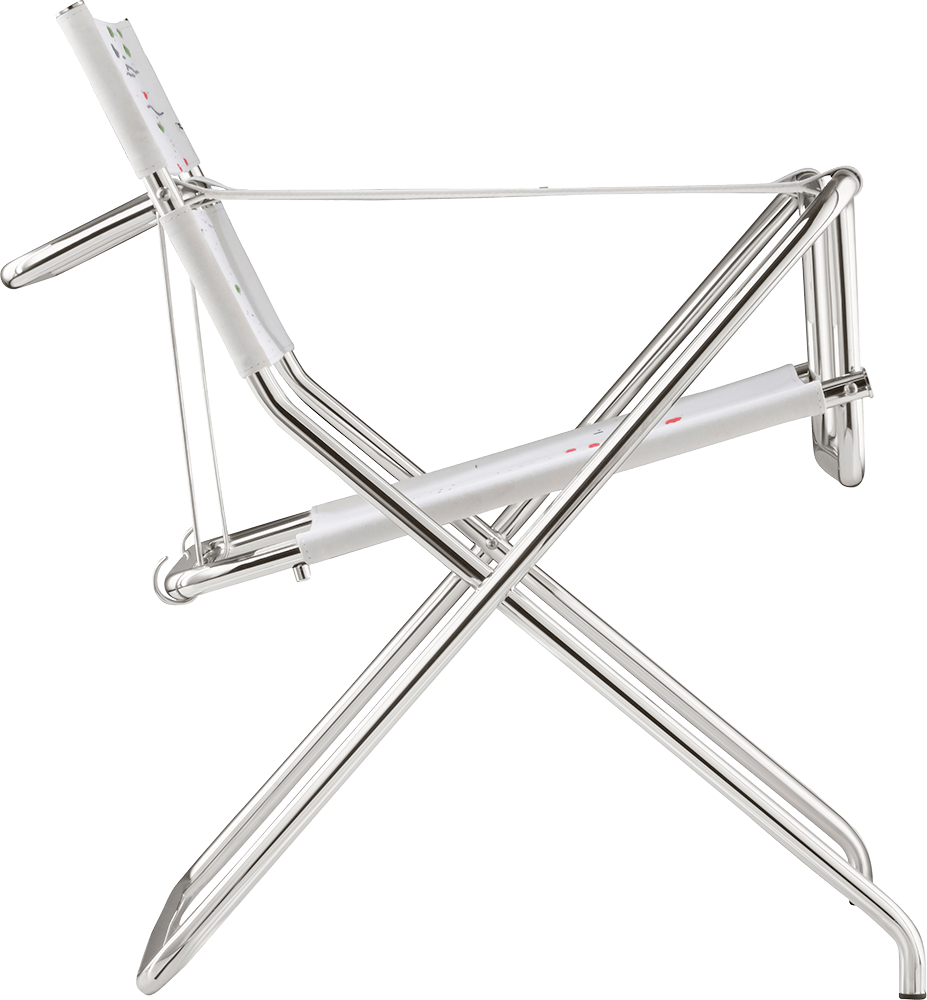
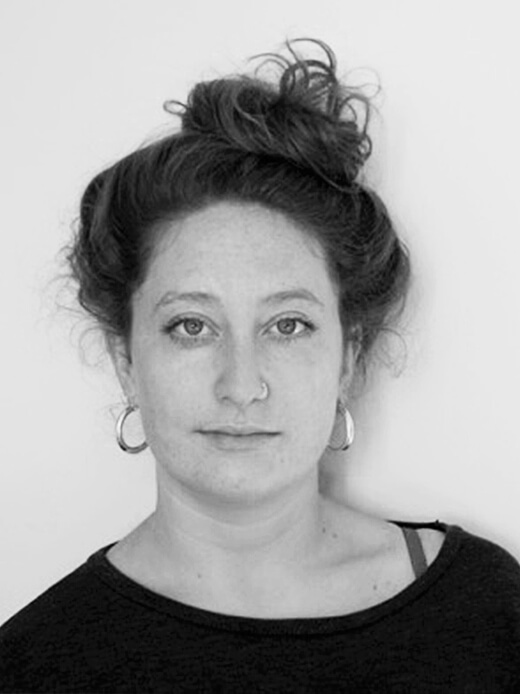
Esther Wilson, granddaughter of the legendary architects Peter and Alison Smithson, works as an artist and embroiderer in London.
+ read more
- einklappen
Before training as an embroiderer at the Royal School of Needlework in London, Wilson completed a degree in fashion communication at the European Institute of Design in Madrid. Fashion plays an important role in Wilson’s current work. She designs and makes clothes to which she applies embroidery for international customers.
For Burberry’s The Makers House collection in 2017, Wilson embroidered cushions with insect motifs using the so-called “blackwork” technique. A form of embroidery with Arab and Persian roots, which was once used to create geometric patterns.
But even far away from the world of fashion, there have always been new and unusual collaborations where Wilson can demonstrate the versatility of embroidery: She works with landscape architect Gali Izard, for example. Esther Wilson teams three-dimensional, traditional embroidery techniques with model making to create organic and constructed tree root formations. She also came up with an unusual concept for the print edition of Bike Magazine, for which she designed 1970s-style embroidery for a headline. In addition, she teaches workshops on her modern embroidery style and concepts, for example at the launch of Threadworks in London. Esther Wilson’s works are featured in many exhibitions in the United Kingdom.
Interview Esther Wilson
The epitome of Bauhaus furniture
You trained as an embroiderer at the Royal School of Needlework in London. A craft that was taught at the Bauhaus but that is rather unusual today. Why did you want to learn this rare profession?
Sewing and embroidery have always rather important at home. This craft has a tradition in my family. My grandmother, the architect Alison Smithson, who developed Tecta’s “Witch House” and museum together with my grandfather Peter Smithson as well as many pieces of furniture, loved sewing. She passed on her knowledge and skills to her daughter, my mother, who in turn passed them on to me. I then decided to focus my skills on embroidery. I am very proud that I could continue this art of my family and now use it for the BauhausNowhaus project.
+ read more
- einklappen
From the perspective of a young British designer: What does BauhausNowhaus mean to you?
Although I completed a three-year course in embroidery with a BA, my work is often graded as a handicraft or women’s work. Today’s division between arts and crafts has created a hierarchy in which techniques such as embroidery or weaving play a subordinate role. The Bauhaus, in contrast, firmly believed in the unity of art and craftsmanship and knew how to combine concept with execution and traditional techniques. This is exactly what is relevant for me in my work today.
What was your idea when Tecta asked you to create a BauhausNowhaus re-edition?
I wanted to reinterpret Marcel Breuer’s D4 and use the Bauhaus Manifesto to create new embroidery designs. The idea of editing texts in an abstract manner has been with me for a long time. It wasn’t about translating words one-to-one into stitch. My plan was only to emphasize certain passages or words with different colours and to use the resulting pattern.
Christian Drescher then sent me a photo of the original manifesto. It was important for me to see what the layout looks like – with the different font sizes and hand-written corrections. All this served as the inspiration for my new designs for the D4.
So you then marked individual words in the manifesto. Their position in the manifesto served as the foundation of your design layout, which consists “only” of embroidered colour blocks…?
Exactly. There are no words to be read. Instead individual words are represented by colours. The first version of the chair showed the words “Bauhaus”, “art” and “crafts” as three different colour blocks. I then continued working on the concept and added punctuation marks.
What does your colour scheme look like?
There are two chairs in white and two in a black fabric that are embroidered in bright colours. I love working with colours. The Bauhaus developed some fabulous colour schemes. I wanted my compositions for the Breuer re-edition to be inspired by this but at the same time look fresh and new. I created lots of different colour schemes before making my final selection. Each of the four chairs features an individual embroidery and colour concept.
How long did it take you to complete a Breuer re-edition?
The embroidery including the creation of a pattern took around 30 hours per chair.
Why did you want to interpret the Breuer chair?
I grew up with this chair. It stood in my grandparents’ house. The epitome of Bauhaus furniture. I love the layered fabric straps and the way they stretch across the steel tubes.
How is your work connected with the Bauhaus?
My designs merge art and crafts. Function, form, longevity play a major role in the creation of beautiful useful products. I like the Bauhaus approach of working with bright colours very much – that is what I try to integrate.
Do you feel like coming home when you visit Tecta in Lauenförde? Your grandparents created the “Witch House” and the museum there.
The first time I went there I was 12. We travelled there by train from London. I was spellbound by the “Witch House” with the tree houses and the undulating paths. It was magical! I was so envious of Axel that he could live there.
Tecta pays the utmost respect to the crafts and materials – this is exactly what I want to express in my work. The synergy between Tecta and my grandparents really created something that was heavenly but at the same time efficient and useful.
Your grandparents Alison and Peter Smithson developed many pieces of furniture for Tecta. What is your favourite?
I have always liked the “Collectors’ Table”. As a child I loved collecting knickknacks and arranged dioramas. The “Collectors’ Table” gave me endless opportunities for rearranging the knickknacks in constantly new ways.
Do you remember Tecta from your childhood, since your grandparents and Axel Bruchhäuser were very close?
Their friendship with Axel was a very special one. It was very present during my entire childhood, be it only for the postcards, funny drawings and work ideas that they exchanged. Axel Bruchhäuser can get really excited about new ideas and projects. Even about a “chair essay” I wrote as a child. By the way, I am working on a Smithson project right now – documenting their Christmas cards. Axel Bruchhäuser was a great help with this. We write each other e-mails, compare images and photos. It’s a great thing that I can continue the friendship between my grandparents and Axel.

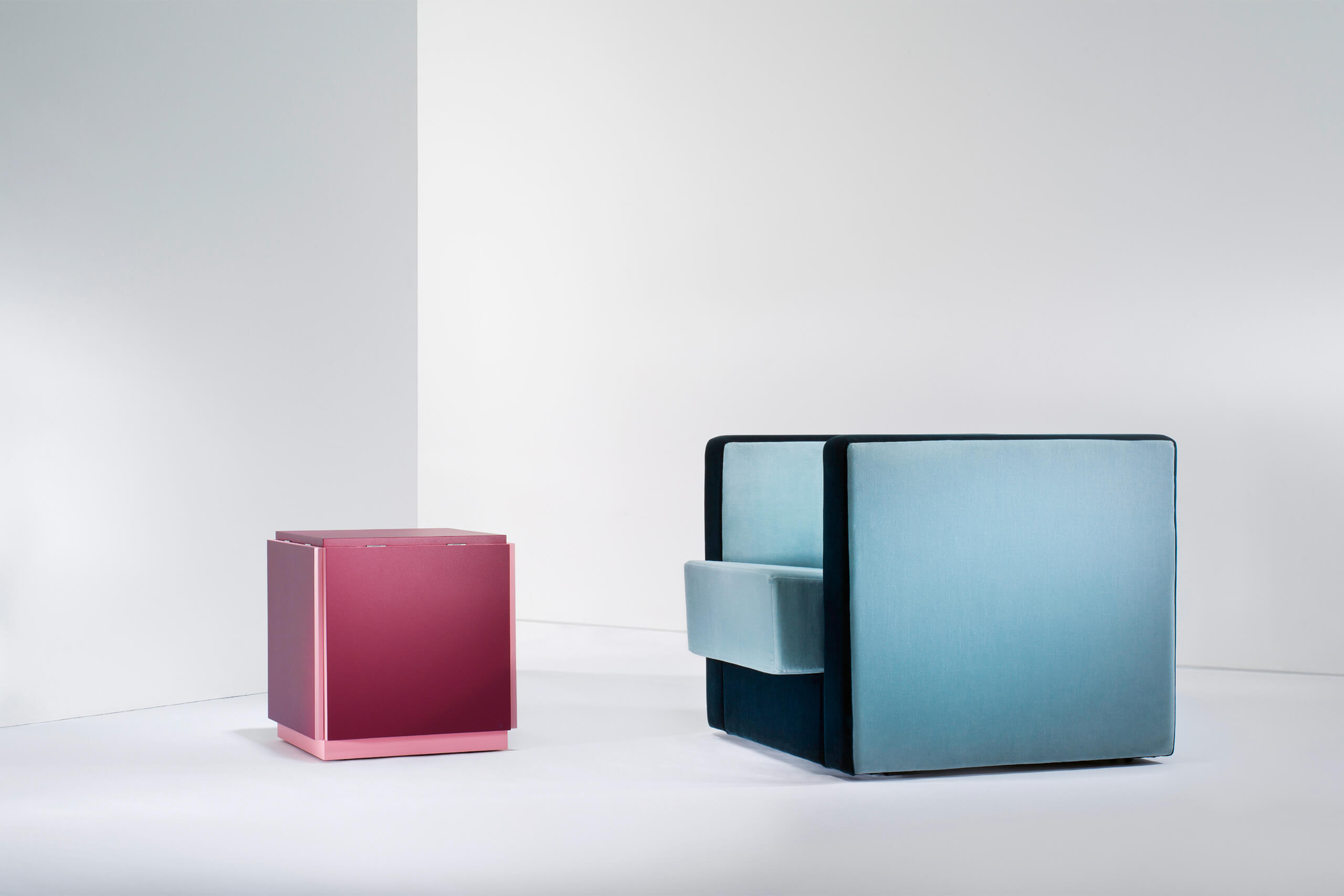
K10N
No longer invisible
Tobias Groß turns unobtrusive folding miracle M10 into a bright and fresh piece of furniture with surprises. An inconspicuous cube, Erich Brendel’s table seems to offer little in the way of discoveries. But then a smile dawns on the viewer’s face, as it unfolds and turns into a Swiss cross, reflecting its source of inspiration – the austere lines of Walter Gropius’ office. In his rethink of the M10, Tobias Groß livens things up: he raises Brendel’s table from its invisibility, giving it a visible, smaller and more colourful design. He maintains the table’s structural character and really makes it stand out. The surfaces and supports of the M10 have been pared down, making them look less solid and creating a lightweight, flexible piece of furniture. The little brother of Erich Brendel’s former tea table.
+ read more
- einklappen
And since a table can nowadays no longer serve for five o’clock tea occasions only, the Cologne designer has reduced its proportions to those of a side table. He has also added a cheerful note to its exterior. A new two-tone design makes the table attractive for modern interiors. Tobias Groß has washed the surfaces in calm, muted colours from olive through red to blue. And he has accentuated the profile edges with fresh pastel hues. Running all around the table, they give it a new, ever surprising, appearance, depending on the position of the panels.
For the BauhausNowhaus campaign the Cologne-based designer has enhanced the M10’s visibility. And in doing so has delivered a timelessly beautiful product that is ready to unfold its true potential in a contemporary interior.
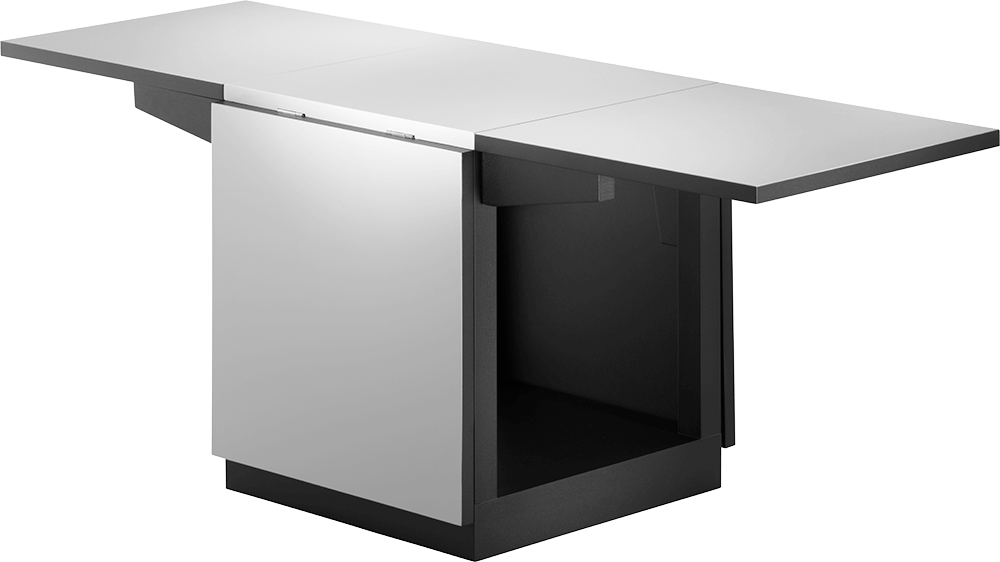
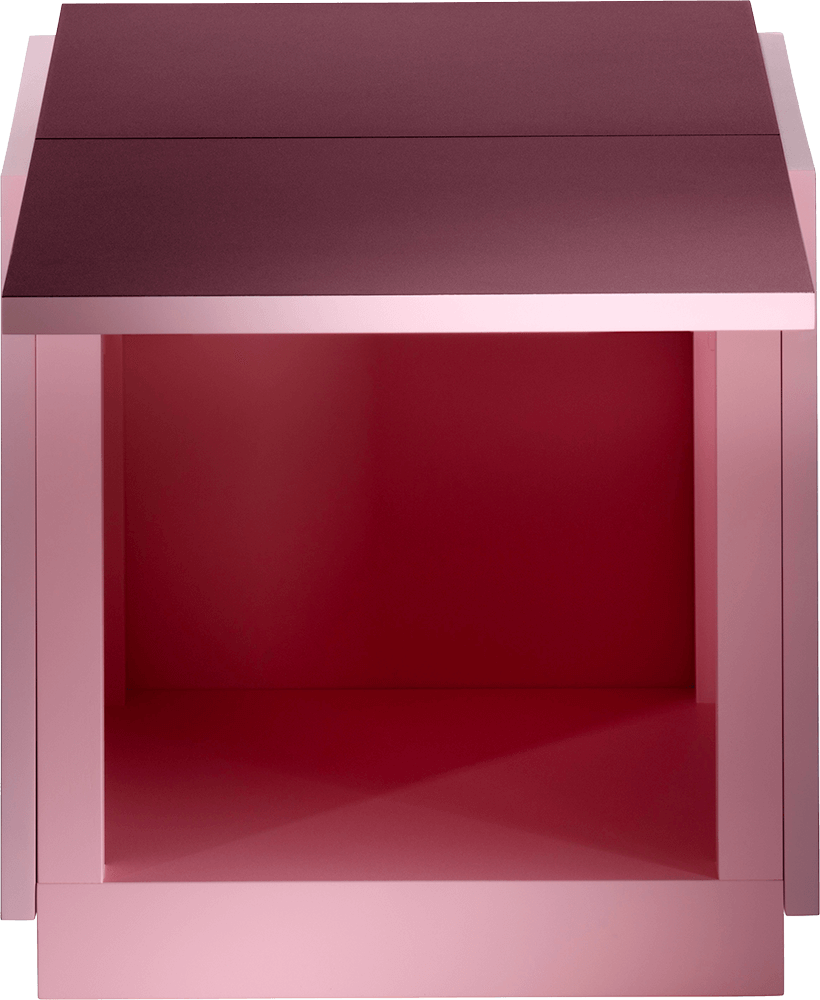
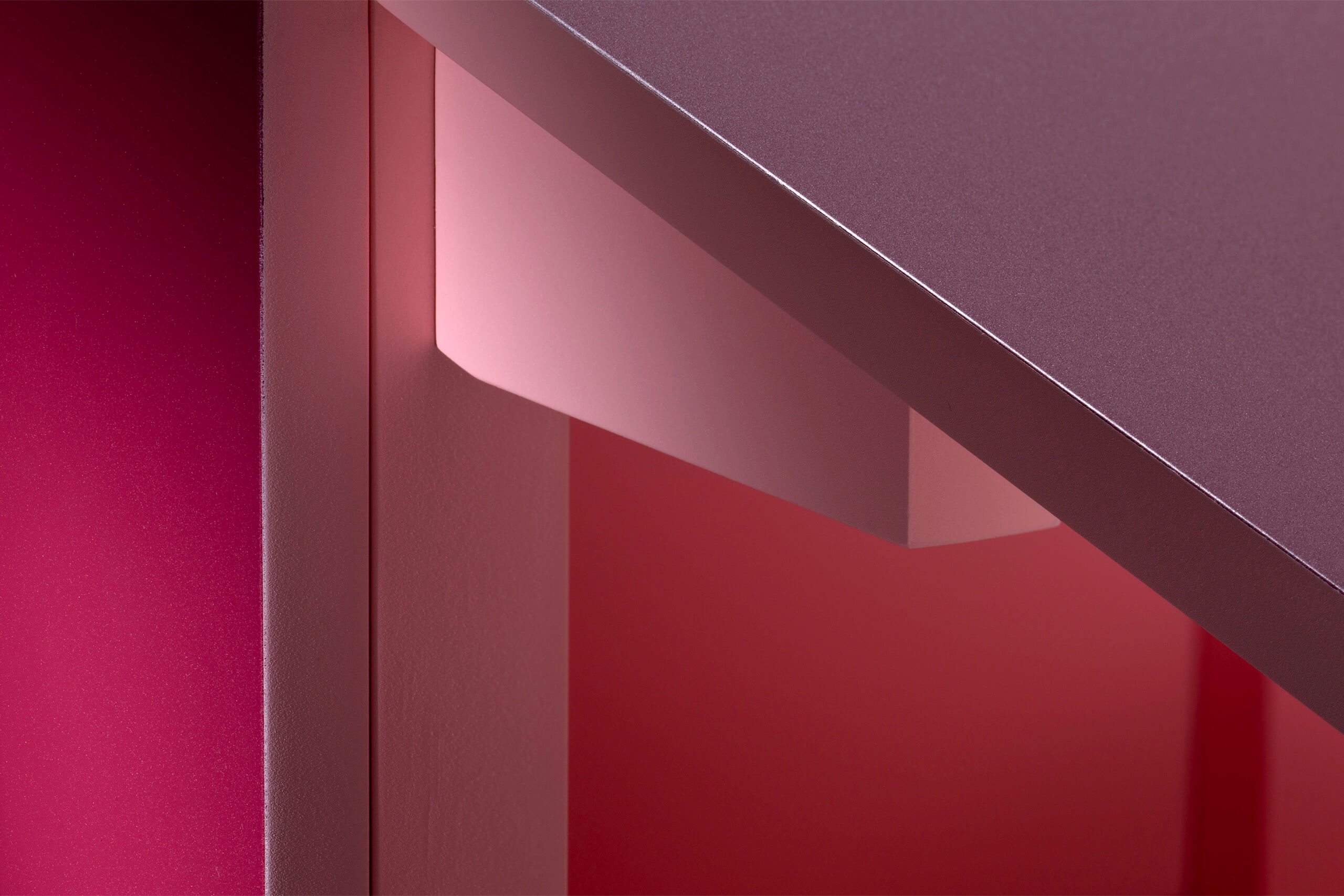
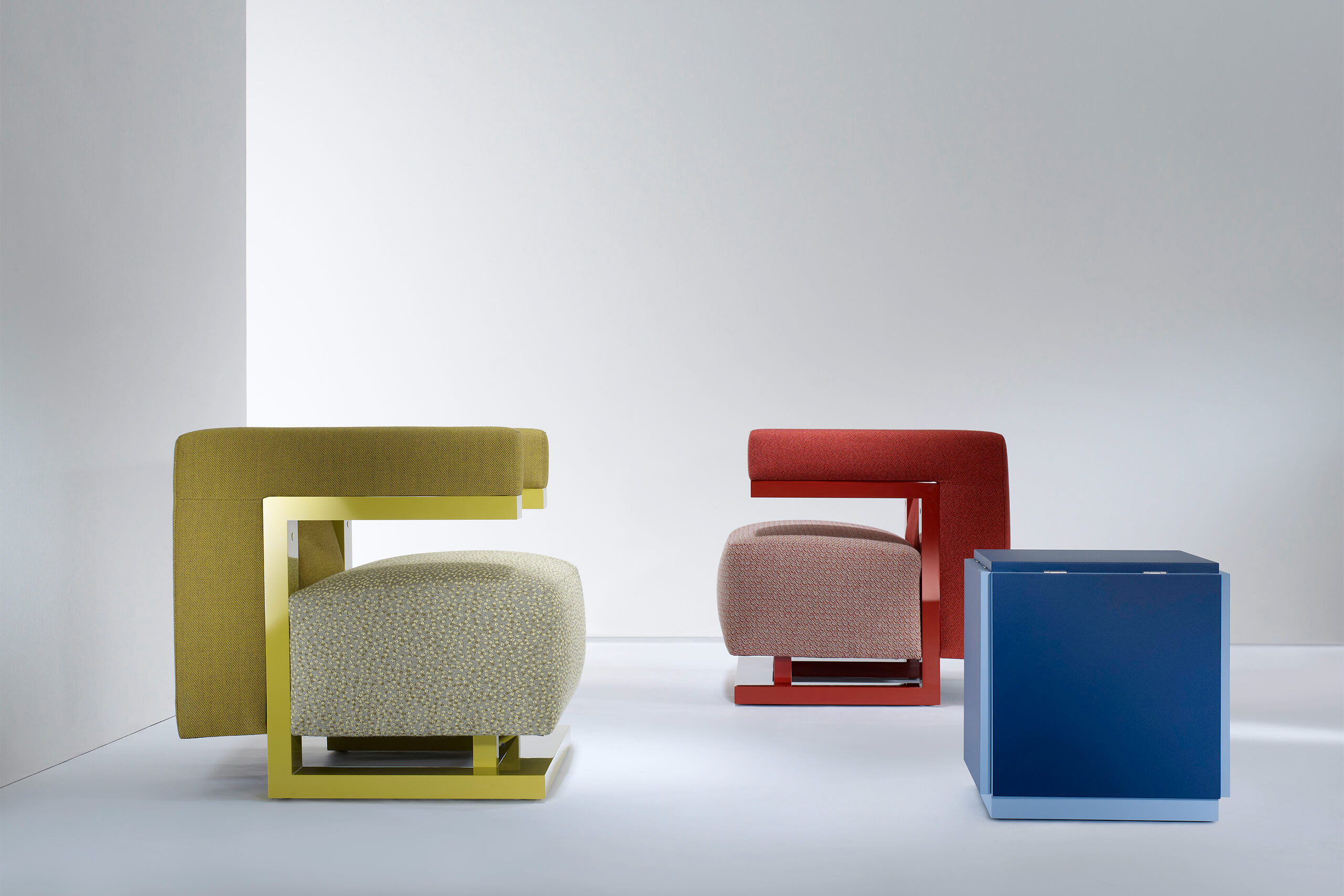
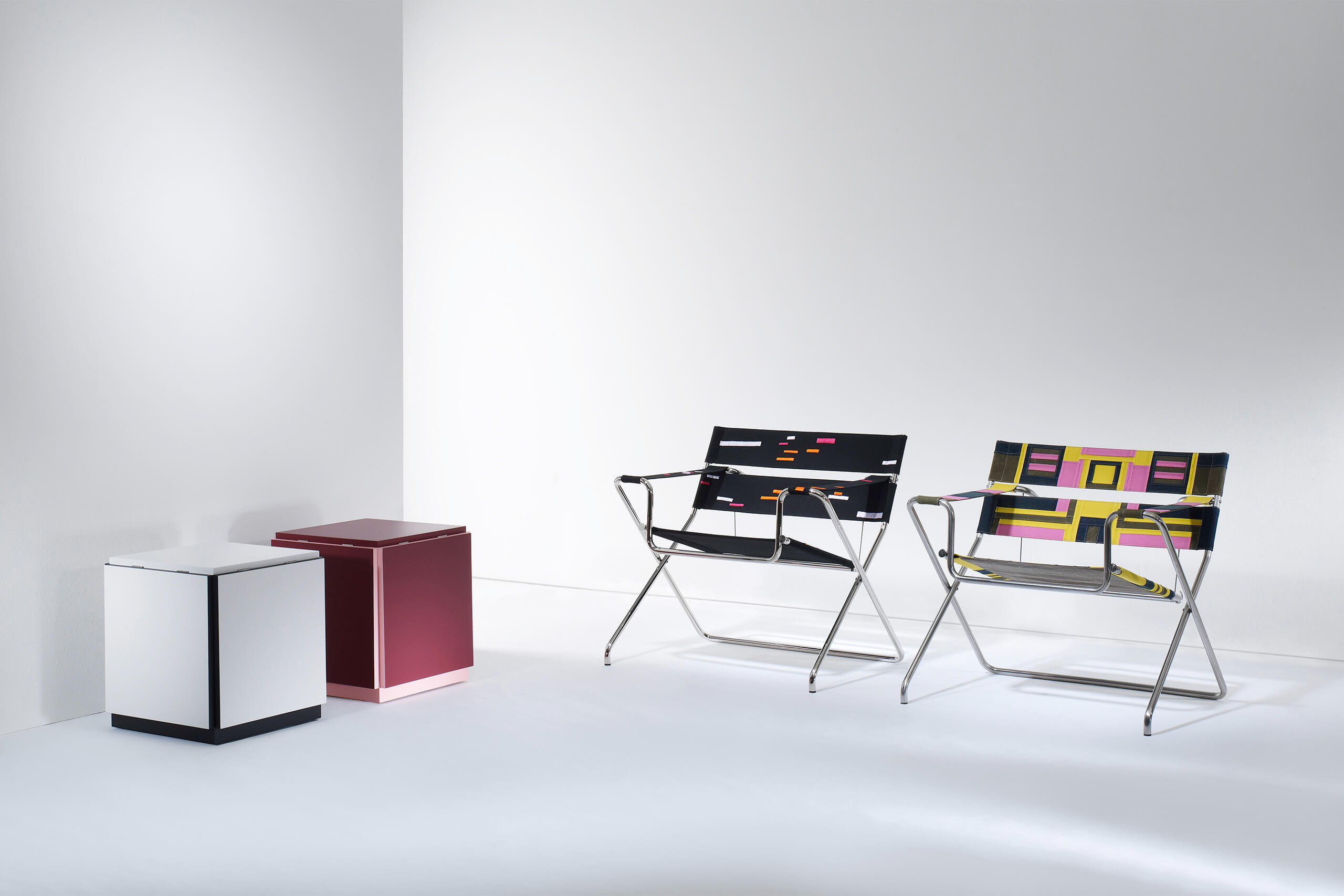

Tobias Groß was born in Braunschweig in 1976, is married and a father of two. From 1997 to 2002 he studied design at Cologne Technical University, graduating with a diploma degree in design. First place in Messe Frankfurt’s First Move Design Awards for his diploma thesis. He has been employed by a number of design agencies, including frog design California, Sunnyvale, Brand Department, in 2003. He founded his own interdisciplinary design studio großgestalten Kommunikationsdesign in Cologne in 2004, and Studio für Gestaltung in Cologne in 2018. He still works for numerous well-known clients in the field of architecture, design, art and culture today. Appointed as lecturer for information design by Rheinische Fachhochschule Köln University of Applied Sciences in 2012.
+ read more
- einklappen
About Studio für Gestaltung, Cologne:
A profound engagement with its customers’ theme worlds is pivotal to the work and projects of Studio für Gestaltung in Cologne. “Our mission is to think forward the attitude and products of our customers,” says agency owner Tobias Groß. “Communication as an extension of the client’s identity.” Team spirit, and an open and interdisciplinary approach are part of the agency’s philosophy. For seven years the studio has also been responsible for communicating the Tecta brand. The minimal but colourful design of the catalogues, brochures and exhibition booths reflect the company’s decision to actively think the Bauhaus forward.
Today, over 50 national and international awards bear witness to the high quality of Studio für Gestaltung’s work. They include: The Most Beautiful German Books, 100 Best Posters, Red Dot Communication Design Award, Design Award of the Federal Republic of Germany, iF Communication Design Award, ADAC Award.
Interview with Tobias Groß
Brendel’s tea table gets edgier and younger
For your mission to reinterpret a piece of Bauhaus furniture, you and your Studio für Gestaltung chose Erich Brendel’s tea table. A piece of furniture that seems rather unobtrusive. What made it appeal to you?
+ read more
- einklappen
Tobias Groß: As designers, we have long been collaborating with Tecta. In the course of our collaboration, I was increasingly struck by this unusual but at the same time demure tea table. It doesn’t draw much attention to itself and has not been much in the spotlight so far. The more we looked at the table, the more enthusiastic we became about it. Brendel’s design is restrained and uncluttered – just like the Bauhaus. It is all about simplicity, functionality, but also playfulness and humour. Things that are very much “today”.
What construction aspects did you like?
Tobias Groß: It’s a table that looks demure but can suddenly appear extroverted, generous and expansive. Thanks to the folding option it can change its appearance in all kinds of new ways. If you fold out one side, it embodies the cantilever aspect – giving it a close connection with Tecta. Each time you open another side it gains a new dimension. The table is simply an ingenious piece of furniture, because you can double, triple or even quadruple its surface.
What did you change in your reinterpretation?
Tobias Groß: Actually, Bauhaus furniture deserves so much respect that you don’t want to change anything at all. BauhausNowhaus played right into our hands as far as the “permissible” question was concerned: what exactly can you still improve about the table? We realised that you can pare it down even further. We let the basic cube shape take centre stage, but we removed the pedestal because it made the cube more vertical. Erich Brendel wanted to add to the table’s height, but we didn’t need the height for our final design.
Is the tea table still intended for its use as a piece of five o’clock furniture today?
Tobias Groß: I think of it as a side table, no longer as a tea table. I tried it out at home, but it was rather intrusive in its old dimensions. We have deliberately reduced its size to fit a young modern home. The surfaces and supports were pared down to create a more lightweight, flexible piece of furniture than before.
What did you want to emphasise about the new table and update for today?
We wanted to emphasise the structural aspect of the table. The hinges are visible and you can see all the structural elements. By emphasising the profile edges with accent colours we want to draw attention to and underline the edgy nature of this piece of furniture. The new two-tone design gives it a fresh contemporary look. For the surfaces we used calm, muted colours: olive, red and blue. The edges stand out in fresh pastel hues. They go all around the table and, depending on the position of the panels, give it a new, surprising appearance.
Do graphic designers have a different way of thinking about products?
As graphic designers we initially had some crazy ideas for the M10’s surfaces. Bauhaus patterns, Pop Art colours, Memphis designs – we tried out all kinds of things. But we then decided against all that, because it was too loud. There’s a lot you can do with cubes. But we didn’t want to downgrade the Bauhaus product to a marketing gimmick or graphic cube. Everything we do has to make sense, with a focus on the construction. We are not after big effects, neither is our Studio für Gestaltung.
Whom would the M10 be suitable for today?
In its current interpretation it would be great for a small home where you need flexible furniture. It is not limited to a specific activity or action but piece of furniture with many different faces. You can use it as a stool if you push it out of the corner. Most products are designed entirely for a specific activity. This can be a help when buying, but more flexibility gives you the huge advantage that the product can serve many different purposes and has a much higher usability.
What would be the next product Studio für Gestaltung could be interested in?
We are fans of Peter Keler. The D1, which is almost a hundred years old, is the epitome of a wheeled armchair as a simple cube. There is a lot you could to with the materials theme. In addition, it would be a great idea to open a “Rolling Tecta Pop-up Café” featuring the wheeled Tecta tables and armchairs, where everything is movable. It would look different every hour, because visitors can change and move everything – be it for two, four or ten guests. That would be a joyful project (laughs).















































































































































































































































































































































































































